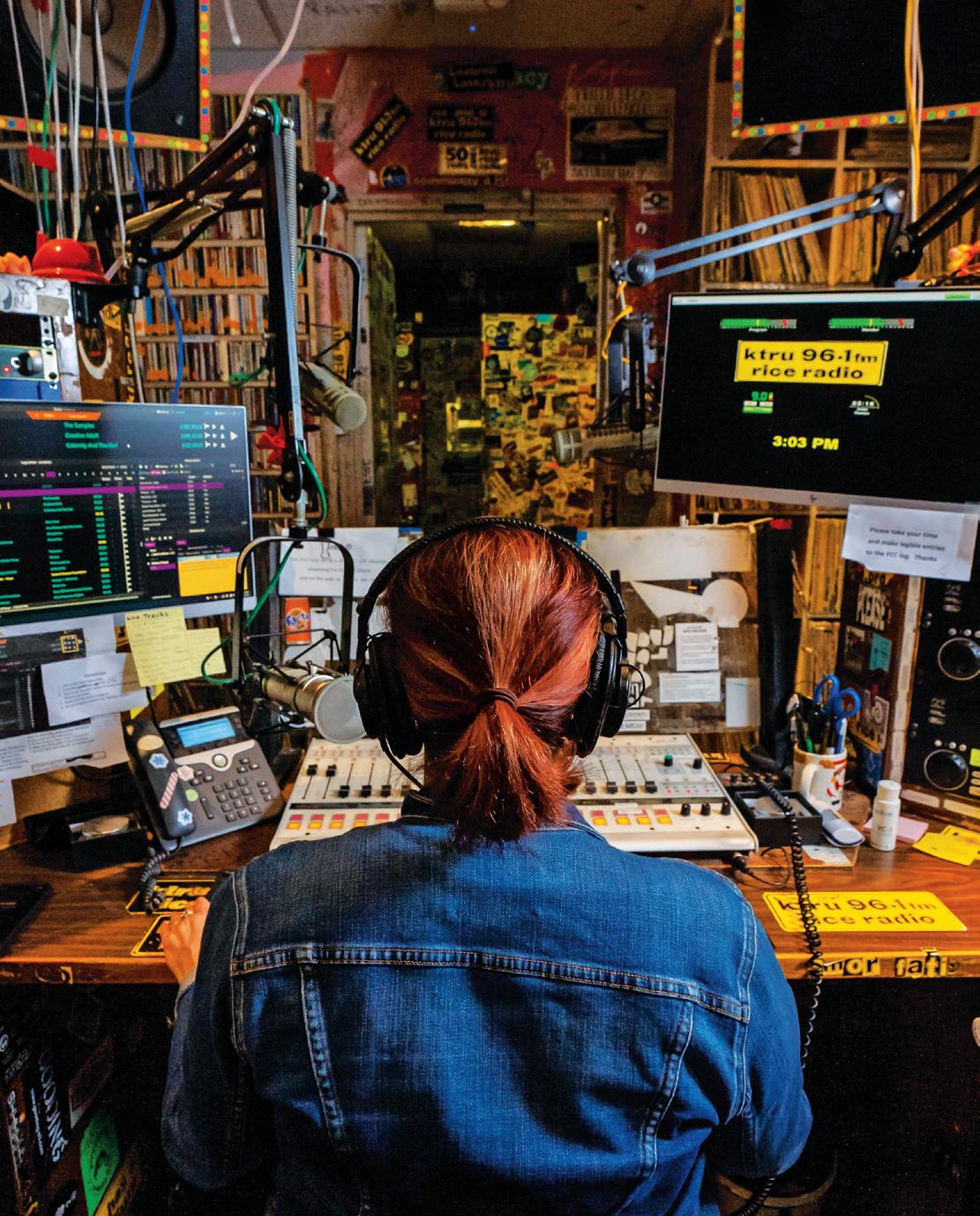
2023
INSIDE KTRU’S HIDDEN ARCHIVE SPRING
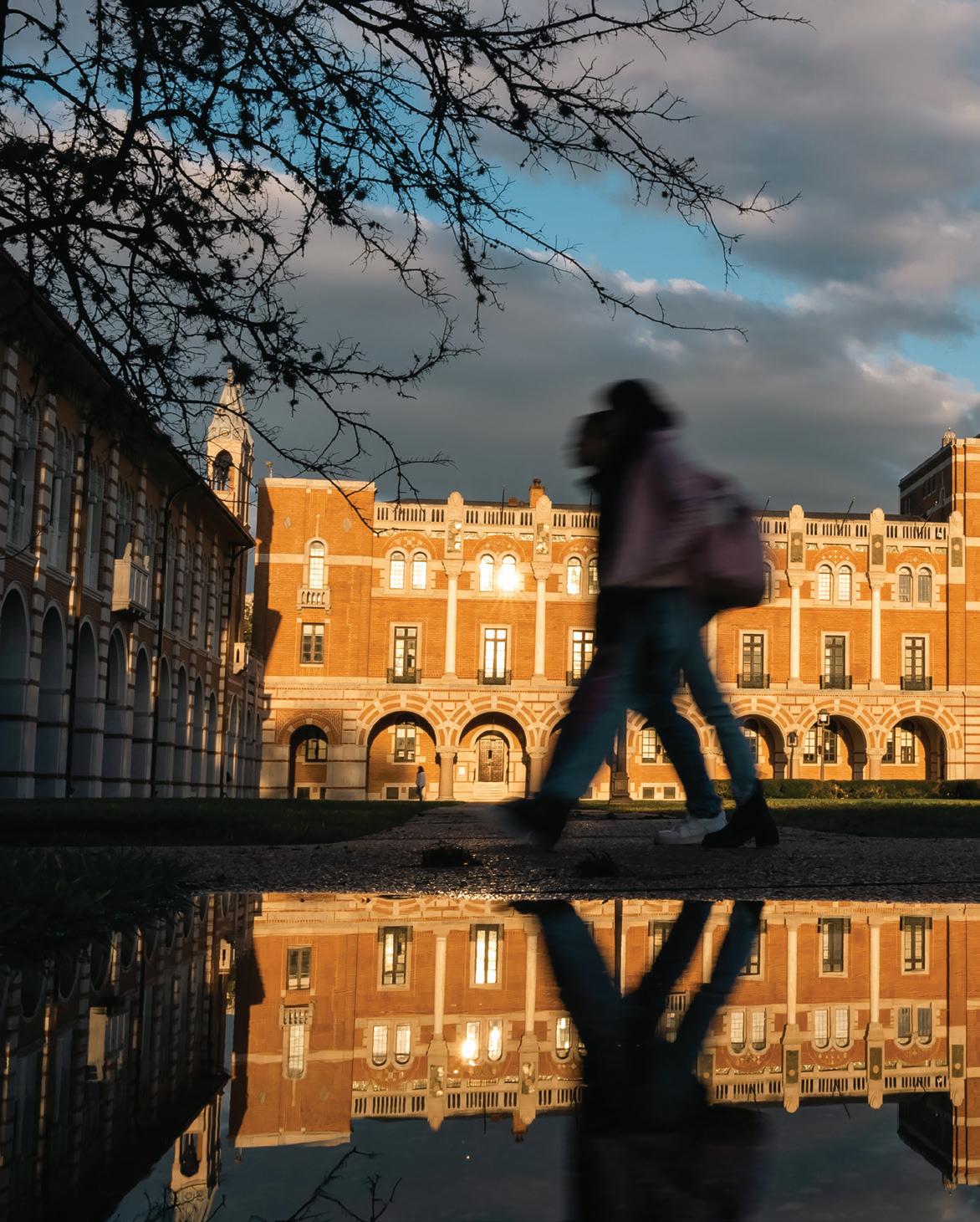 Lovett Hall mirrored in puddles of rain on the morning of Feb. 1, 2023
PHOTO BY BRANDON MARTIN
Lovett Hall mirrored in puddles of rain on the morning of Feb. 1, 2023
PHOTO BY BRANDON MARTIN

MAGAZINE.RICE.EDU 3
FEATURES
26
Record Enthusiasm
Five decades of KTRU DJs are linked by their love of the music and a unique archive of thousands of music reviews.
34
Physician, Heal Thy World
Vuong “Von” Nguyen ’97 harnesses technology to improve access to health care and mitigate impacts of climate change.
38
Crew Phi Crew
Ten alumnae share the story of their enduring friendship born at Rice more than 25 years ago.

4 RICE MAGAZINE SPRING 2023 RICE MAGAZINE SPRING 2023
ILLUSTRATION
CONTENTS
BY CHLOE ZOLA
DEPARTMENTS
Sallyport 9
A mixed media artist, Hanszen’s new wing, the art of math, H&D’s Kevin Yuen ’20 and RMC’s enduring musical gift

Wisdom 17

Trusting appearances, NEH grants, Post Houston, talking fungi, 3D-printing breakthroughs, faculty books and gas vs. electric

Alumni 43
A game show fanatic, better skin cancer detection, moderation in all (Rice) things and a Classnotes sampler from Owlmanac
Last Look 50
Artist Bennie Flores Ansell installs an exhibition at the Moody consisting of hundreds of 3D-printed and ceramic wishbones.

MAGAZINE.RICE.EDU 5
CLOCKWISE
RICE MAGAZINE SPRING 2023
FROM TOP LEFT: PHOTO BY BRANDON MARTIN, ILLUSTRATION BY MIGUEL PORLAN,
PHOTO BY GUSTAVO RASKOSKY, PHOTO BY JEFF FITLOW
Joe Nick Patoski (“Record Enthusiasm”)
is a former staff writer for Texas Monthly and the Austin AmericanStatesman and has authored or co-authored biographies of Willie Nelson, Selena and Stevie Ray Vaughan. In 2015, he directed the documentary “Sir Doug and the Genuine Texas Cosmic Groove.” Every Saturday, he hosts the Texas Music Hour of Power on Marfa Public Radio and Wimberley Valley Radio. See joenickp.com.
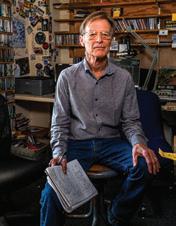
Gustavo Raskosky (“Record Enthusiasm”)
joined Rice as a staff photographer and videographer last October.
“I find storytelling through digital media to be one of the most essential ways of sharing unique perspectives and experiences today.” His experience includes creating digital content for Tokyo Fashion Week, tech startups and fitness brands. A dedicated runner, Raskosky recently qualified for the Boston Marathon.
Chloe Zola
(“Crew Phi Crew”) is often motivated by social justice issues and current affairs in her illustrations. Her interests include yoga, chocolate chips and learning Spanish at a glacial pace. She lives in San Miguel de Allende, Mexico. See chloezola.com.
Alexander Gelfand
(“Physician, Heal Thy World”) is a writer based in New York City who specializes in working with colleges, universities and nonprofit organizations. His portfolio of stories ranges from artificial intelligence and biomedical research to climate change and criminal justice. See alexandergelfand.com.
Audra Melton
(“Physician, Heal Thy World”) is a photographer based in Atlanta whose commercial and editorial work often focuses on social issues. “My roots are in the American South, and I am as passionate about doing work here as any other place in the world.” Melton’s photography has appeared in many publications, including National Geographic, The New Yorker and Garden & Gun. See audramelton.com.
Delphine Lee
(“Classnotes”) is an illustrator and artist based in Washington, D.C. Her clients have included The Economist, The New York Times, Lonely Planet and many university magazines. She loves to create images “that explore common themes in everyday life and to break down complexities into smaller palatable bits through humor and sensitivity.” See delphinelee.com.
RICE MAGAZINE
Spring 2023
PUBLISHER
Office of Public Affairs
Jeff Falk, interim vice president EDITOR

Lynn Gosnell
ART DIRECTOR

Alese Pickering
DIRECTOR OF MARKETING
Lisa Yelenick
EDITORIAL DIRECTOR
Tracey Rhoades

ASSISTANT EDITOR
Hilary C. Ritz
PHOTO/VIDEO
Jeff Fitlow
Brandon Martin
Gustavo Raskosky
CONTRIBUTORS
Eva Bee, Silvia Cernea Clark, Daniel Cohan, Sol Cotti, Rachel Fairbank, Alexander Gelfand, Jennifer Latson, Delphine Lee, Amy McCaig, Audra Melton, Laura Furr Mericas, Alex Eben Meyer, Paddy Mills, Nico Oved, Joe Nick Patoski, Miguel Porlan, Jenny West Rozelle ’00, Mike Williams, Chloe Zola
INTERNS
Emma Korsmo ’24
Mabel Tang ’23

Rice Magazine is published four times a year and is sent to university alumni, faculty, staff, parents of undergraduates and friends of the university.
© April 2023, Rice University
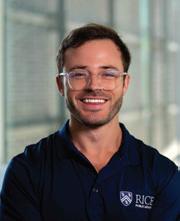
6 RICE MAGAZINE SPRING 2023
CONTRIBUTORS
THE RICE UNIVERSITY BOARD OF TRUSTEES
Robert T. Ladd, chair; Elle Anderson; Bart Broadman; D. Mark Durcan; Michol L. Ecklund; Wanda English Gass; Terrence Gee; George Y. Gonzalez; James T. Hackett; Patti Lipoma Kraft; Holli Ladhani; Lynn A. Lednicky; Elle Moody; Brandy Hays Morrison; Asuka Nakahara; Brian Patterson; Byron Pope; David Rhodes; Gloria Meckel Tarpley; Jeremy Thigpen; Claudia Gee Vassar; James Whitehurst; Lori Rudge Whitten; Randa Duncan Williams; Michael Yuen.
ADMINISTRATIVE OFFICERS
Reginald DesRoches, president; Amy Dittmar, provost; Paul Cherukuri, vice president for Innovation; Jeff Falk, interim vice president for Public Affairs; Kelly Fox, vice president for Finance and Administration; Caroline Levander, vice president for Global and Digital Strategy; Paul Padley, vice president for Information Technology and chief information officer; Yvonne Romero Da Silva, vice president for Enrollment; Ronica Smucker, interim vice president for Development and Alumni Relations; Omar A. Syed, vice president and general counsel; Allison Kendrick Thacker, vice president for Investments and treasurer.
POSTMASTER
Send address changes to: Rice University
Development Services–MS 80
P.O. Box 1892
Houston, TX 77251-1892
EDITORIAL OFFICES
Creative Services–MS 95
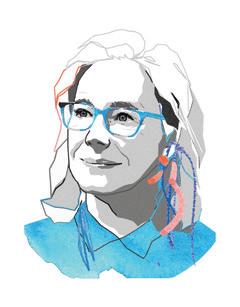
P.O. Box 1892
Houston, TX 77251-1892
Phone: 713-348-6768
ricemagazine@rice.edu
STAYING TRUE
IT’S SPRING BREAK — the campus is quiet, the tree canopy is leafing out with bright green growth, and we’ve sadly said goodbye to this year’s showy display of pink and white azaleas. But we’re anticipating the pomp and circumstance of commencement and the end of another academic year.
In this issue, we continue to mark a time of renewal and rebuilding at Rice — both in our collective traditions and physical surroundings. It’s part of a year of welcoming the return of beloved traditions and the arrival of new ideas and change that are the hallmarks of a vibrant campus community.
The stories in our spring issue by and large reflect these themes — but in the Riceiest ways possible. We are delighted to deliver a cover feature that celebrates resilient and beloved KTRU Rice Radio. In this story, writer Joe Nick Patoski dives into KTRU’s oneof-a-kind archive of student-written record reviews, while also taking stock of the entertaining, diverse and musically challenging programming that runs 24/7. The scrawled reviews are time stamps of musical tastes and trends — comically profane, frequently insightful and deftly penned. We thank Katharine Shilcutt, director of student media and a station DJ herself, for bringing this treasure to our attention.
In every issue, we bring readers stories about the achievements of our individual graduates, and we’ll continue to do so. But we are over the moon to share a beautiful story of friendship
among a group of accomplished Black women who attended Rice in the mid-1990s. Writer and alumna Jenny West Rozelle ’00 traces the group’s origin story, shared memories, achievements and faithful bonds “through thick and thin, victory and obstacle.” We are grateful to Chaundra Frank ’00 for reaching out and sharing this idea for a story with us. We hope this story generates more tales of enduring Owl friendships.
Between these features — and a fascinating Q&A with physician Vuong “Von” Nguyen ’97 on his work to develop machine learning and AI-driven methods to address health care and climate change issues around the world — we’ve loaded up the issue with tales of student achievements, Hanszen’s new (new) wing and essential staff. In research news, we’ve got stories on mushrooms and meteorites and an explainer on why gas stoves have become such a heated topic. The stories in our alumni department will make you think — and some will make you laugh. Tell us what you enjoyed by writing to us at ricemagazine@rice.edu
ILLUSTRATION BY PADDY MILLS MAGAZINE.RICE.EDU 7
FROM THE EDITOR
It’s part of a year of welcoming the return of beloved traditions and the arrival of new ideas and change that are the hallmarks of a vibrant campus community.
ALL WELCOME AND HEARD
UNIVERSITIES ARE PLACES of learning, where curiosity and discovery are key to understanding the world and our place in it. They are also places where diverse perspectives and ideas are welcomed and critical thinking is fostered. These characteristics are vital to the development of a vibrant intellectual community that produces well-rounded individuals capable of meaningfully contributing to society.
At Rice, bringing diverse voices to the table is a top priority. Our makeup has changed drastically since opening our doors more than 100 years ago. The university is now home to students, faculty and staff who are a multicultural reflection of the world.
While we have much to celebrate regarding Rice’s rich diversity, I recognize that such efforts are part of a bigger goal where all voices are welcome, civil discourse is maintained and diversity of thought is encouraged.
It is crucial to create an environment where individuals are not afraid to express their views, even if they are unpopular or controversial. This is because universities are where individuals learn to think critically, express their opinions and listen to others who have opposing viewpoints.
This is exactly the type of place I recall from my days as a doctoral student at the University of California, Berkeley. My fellow classmates came from various parts of the world and held a wide range of religious, political and social viewpoints. As we spent hours waiting for our computer codes to run, we debated a range of topics — free from personal attacks and insults — and usually ended up agreeing to disagree, but with a greater appreciation for each other’s viewpoints. These discussions made me realize the important role that culture, society and lived experiences play in shaping our views of the world.
As the American Council on Education has noted, learning within a diverse setting also prepares students to become good and effective citizens in an increasingly complex, pluralistic and often polarized society; fosters mutual respect and teamwork; and helps build communities whose members are judged by the quality of their character and their contributions. Such an environment enhances America’s economic competitiveness by fostering innovation and creativity.
The goal for Rice is to excel at creating not only a diverse environment but also an inclusive and equitable one. This objective is essential for us to successfully compete for and
recruit the world’s most talented and promising students, faculty and staff. This fall, we established a new general education requirement for all incoming undergraduate students. These courses focus on how differences are understood across human societies, how those understandings have changed over time, and the consequences such understandings have on human development, flourishing and knowledge.
As we grow the university, we will remain committed to our residential college system — a system that creates a close-knit environment and a place where differences are celebrated and debates occur over meals, in study halls and late into the evening. Recently, two residential positions in the Office of Multicultural Affairs were created to provide focused support to the residential colleges through enhanced college-based advising and programming on issues related to cultural awareness and inclusivity — with one of the new positions focused particularly on LGBTQ+ life at Rice.
As it concerns socioeconomic diversity, we have increased our efforts to support first-generation college students through various programs on campus that provide financial, academic and social support. The Rice Investment is among the most generous and transparent financial aid programs in the nation and greatly expands support for low- and middleincome families, eliminating tuition and loans for many talented students.
There are several programs at Rice geared toward graduate students as well, a growing population at Rice. One such program is the Graduate and Postdoctoral Studies Pathways Program, which acknowledges the unique challenges faced by graduate students and addresses them through cross-disciplinary, community-based programming.
In addition to our commitment to attract a diverse student body, we’ve also recruited our most diverse group of talented faculty over the past several years — doubling, for instance, the number of Black professors in the past five years and increasing our number of female hires, particularly in fields such as science and engineering where women faculty remain underrepresented.

It is important, too, that the university continues to develop a wider range of institutional partnerships that reflects and strengthens the relationship between diversity and excellence at Rice. Our resolve to be a truly global university and our expanding collaborations with universities around the world, local community colleges, minority-serving institutions, veteran’s organizations and others reflect this commitment.
Diversity, equity and inclusion are foundational values that underscore everything we do and are essential to achieving success in all facets of our mission. I look forward to working with all of you to strengthen our efforts so that the university fully embraces the widest breadth of knowledge, thought, perspectives, experiences and backgrounds.
8 RICE MAGAZINE SPRING 2023 ILLUSTRATION BY PADDY MILLS PRESIDENT DESROCHES
It is crucial to create an environment where individuals are not afraid to express their views, even if they are unpopular or controversial.
ARTS AND SCIENCE Creation Unfolding
BY HILARY C. RITZ
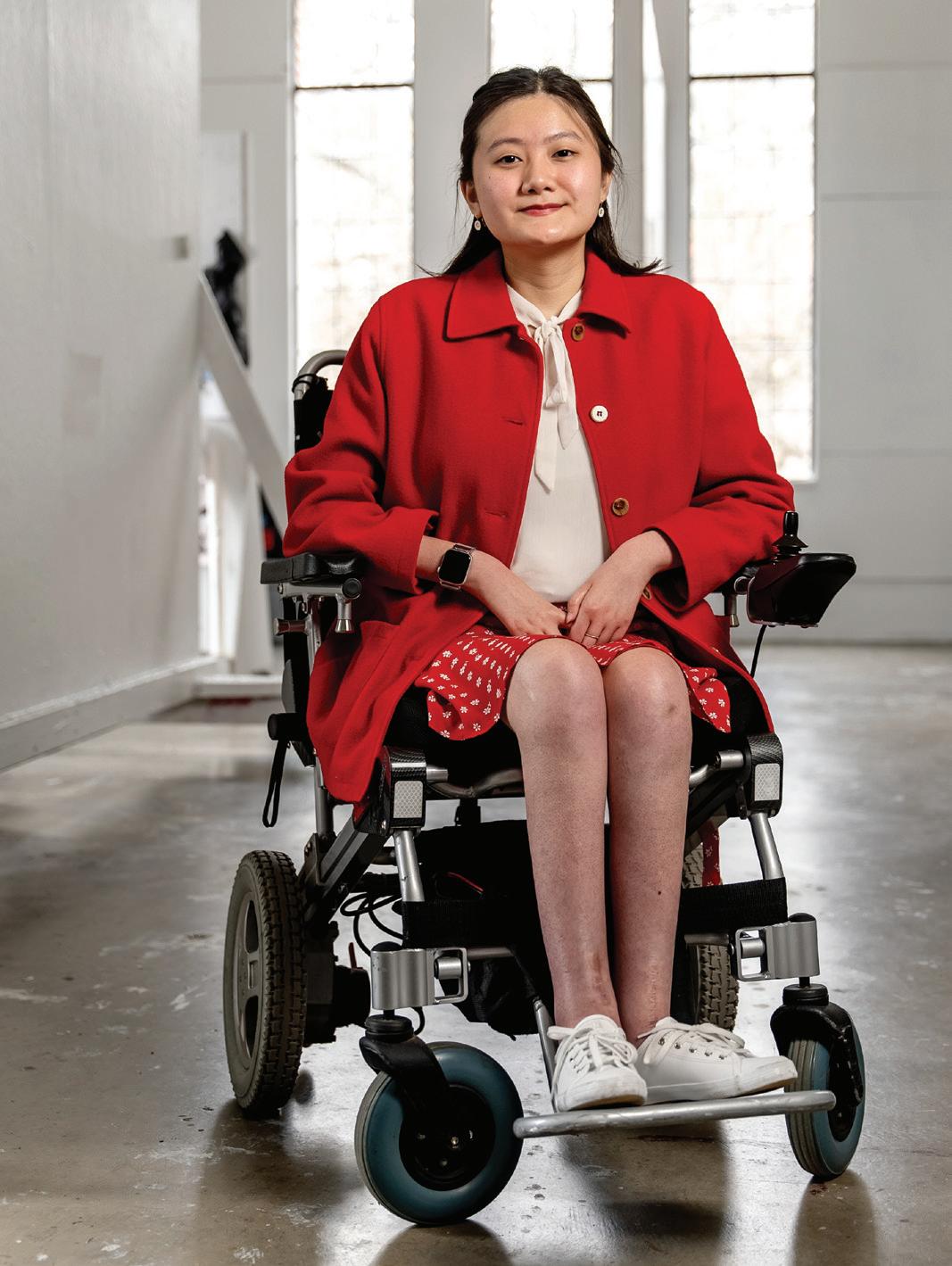
Ling DeBellis pushes the boundaries of what makes us human.
9 SALLYPORT CAMPUS NEWS AND STUDENT LIFE
PHOTO BY BRANDON MARTIN MAGAZINE.RICE.EDU
MIXED MEDIA
artist and evolutionary biologist Ling DeBellis ’23 recently wrote on Instagram, “I am not one thing. I am Vietnamese. And Chinese. And American. And Jewish. I use a wheelchair. But I walk sometimes too. I am a scientist. I am an artist too. These are my labels ... but they do not define me.” And it seems unlikely that she will be pinned down anytime soon.
DeBellis’ story begins in southern China, close to the Vietnam border. Born in an orphanage, she suffered a “polio-like illness” in early childhood but found a loving home with adoptive parents in Minneapolis, Minnesota. That blend of cultures and experiences, she says, has shaped what she’s studied and how she has combined her passions.
According to her website, DeBellis’ vision is to create a world where art and science are complementary, bridging the divide between creativity and analysis. She adds, “Life without science is a world without discovery. Life without art is an empty abyss ... To be human is to balance both.”
She has taken this vision seriously, producing several notable installations in the last three years, including her latest offering, “Butterflies,” an experimental film that showed at the
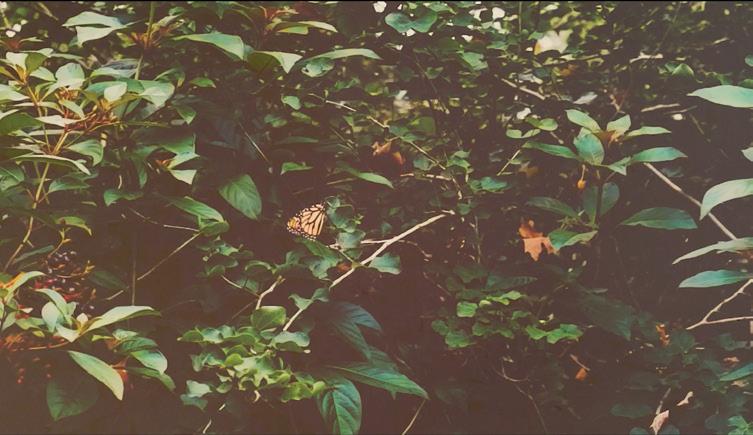
Sleepy Cyborg Gallery in Sewall Hall Jan. 20–Feb. 19. Created by DeBellis and composer Antonio Sanz Escallón, “Butterflies” is presented in three sections and centers around “DeBellis’ semi-autobiographical abstraction in response to maturity, femininity and changing perspectives over the past several years.” The final section DeBellis describes, in part, with the powerful words, “Wherever I go, my body is mine.”
As she has developed her vision as an artist, DeBellis has produced works that are unconventional, to say the least. Just when we think we might understand her artistic direction, she catches us off guard with something altogether different.
“Quercus Avium” features a slowly shifting light program in the canopy of Martel Quad’s sprawling live oak accompanied by a 28-minute birdsong soundscape — lovely and atmospheric and similar in some ways to “Butterflies” — but then we discover her works “Regurgitation” and “Spermatozoa” and that they are, in fact, accurately named.
The former offers “an aesthetic critique on the sexualization and fetishization of Asian women” through
a depiction of Asian women chewing up and spitting out exotic fruit, while the latter is an artistic presentation of real human semen preserved in transparent epoxy beverage coasters as a “literal conversation starter on human sexuality.”
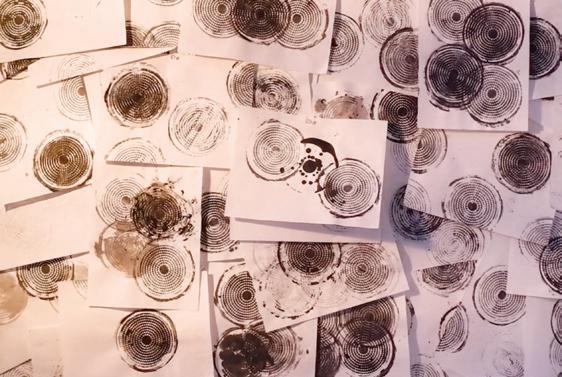

But then again, “Le Boeuf en Concert” presents violinist Connor Chaikowsky ’23 and pianist Tomás Jonsson ’22 playing Sergei Dreznin’s “Circus Fantasy” alongside footage from the 1936 Soviet film “Circus,” which DeBellis spent painstaking hours editing frame by frame to fit the music. The result is an enchanting nine-minute journey into a bygone era. DeBellis is right; she certainly isn’t “one thing” — not any more than art or science are one thing. She says, “Rice has been such an awesome sandbox to play around in, with different disciplines and different fields. ... I’m going to keep pushing those boundaries of understanding us and why we’re here.”
And her viewers will continue to watch her unfold with fascination.
SALLYPORT 10 RICE MAGAZINE SPRING 2023 STILLS FROM “BUTTERFLIES” (2023) BY LING DEBELLIS AND ANTONIO SANZ ESCALLÓN
SYLLABUS
Math All Around Us
MATH 115
The Art of Math DEPARTMENT
Mathematics
DESCRIPTION
This course is primarily for students majoring in non-STEM fields. The goal of the course is to demonstrate that math is more than formulas — it is a process of thinking which is relevant to students on a daily basis.


WHAT PREREQUISITES do non-STEM majors need to be successful in The Art of Math? “As long as students know basic algebra, they will be able to follow the class,” says Betul Orcan-Ekmekci, assistant teaching professor of mathematics. “More importantly, they need their courage, self-belief and patience.” It’s a confidencebuilding message that she takes care to repeat in every class.
Throughout the spring semester, her students engaged in a wide range of lessons related to geometry, number theory and topology. In a recent class, OrcanEkmekci led students through a step-by-step process to both understand and appreciate one of the most famous sequences in geometry — the Fibonacci sequence. She began by sharing images of the spiral patterns of seeds in a sunflower and the tops of pine cones, demonstrating the presence of math in nature. Turning to a chalkboard, she

wrote the numerals 1, 1, 2, 3, 5 and 8, before asking students to add more numbers — 13, 21, 34 and so on — to the sequence. Soon, the board began filling up with equations, from simple ratios to complex quadratic formulas.
Orcan-Ekmekci’s highly interactive teaching style constantly engaged her students’ attention. “Did you follow it? I don’t want to lose you,” she repeated. Every few minutes, she paused to give students a moment to check on any stumbling blocks. By the end of the hour, students had been led from the Fibonacci sequence to the golden ratio, which would be the subject of their next lesson and weekly homework. “She’s extremely patient, and she’s also really encouraging,” says Sara Davidson, a sophomore majoring in political science and German.
To bring home the point that math may underlie creative expression, the semester culminated in art and music projects inspired by the class’s reading of the “The Runaway Species: How Human Creativity Remakes the World,” written by professor and composer Anthony Brandt of the Shepherd School of Music and neuroscientist David Eagleman ’93.
“Math is not just formulas or these complicated problems,” Orcan-Ekmekci says. Math is another language that helps us understand the world around us and can inspire creativity. “Our purpose is also to understand nature with math’s language.” —
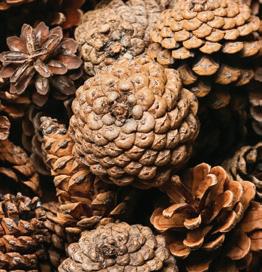 LYNN GOSNELL
LYNN GOSNELL

MAGAZINE.RICE.EDU 11 PHOTOS BY 123RF.COM
RESIDENTIAL COLLEGES
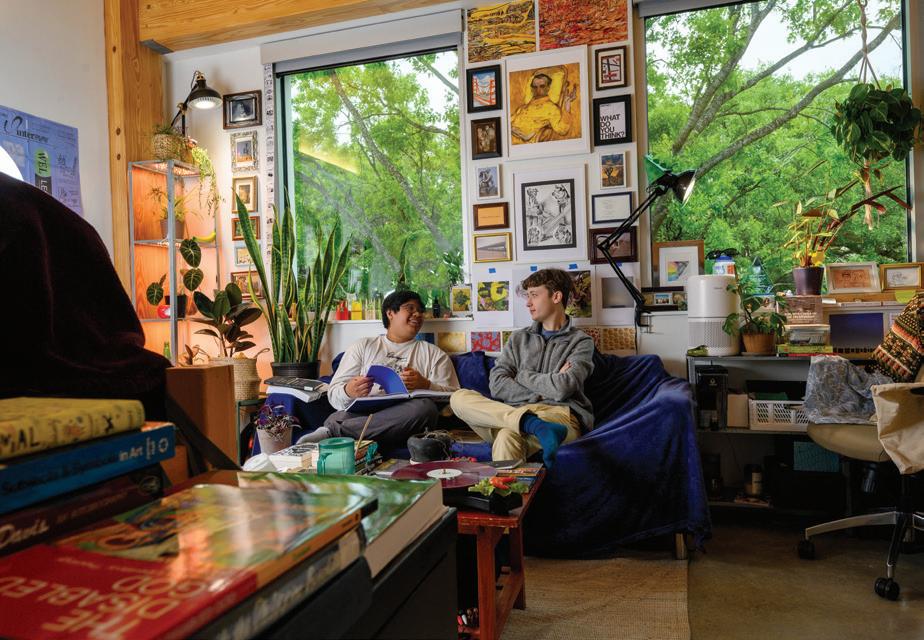
First Impressions
Hanszen’s new mass timber wing welcomes students with natural grace.
IN JANUARY, I moved into a single room in the new Hanszen wing for my last semester at Rice, and right away, I was struck by the quaint intimacy of the wooden panels of the ceiling, the spaciousness of the room and the copious amounts of natural light that streamed through the windows. Compared to the sterility of the stucco walls and the windows shoved into the corners of my previous suite in Old Sid, the natural elements were refreshing and comforting.
Hanszen officially welcomed students to its new mass timber-constructed wing starting this past January. The spacious addition features five floors, 166 beds, 38 singles and two residential associate apartments. Construction began following the demolition of the previous
wing in May 2021 and was projected to be completed by the beginning of the fall 2022 semester. However, delays caused by the COVID-19 pandemic’s effect on the supply chain and barriers to transportation at the U.S.–Canada border pushed completion back, said Mark Ditman, who was the associate vice president of housing and dining during the course of the project.
My new home is certainly unique. Unlike traditional American wood light-frame construction, which relies on smaller interspaced units fastened together to form a building’s skeletal structure, mass timber is a construction technique that laminates smaller pieces of wood into large structural elements such as beams and supports. Mass timber construction is also highly industrialized, which allows for greater precision, control and quality.
Rice architecture professors Jesús Vassallo and Albert Pope, whose 2016 model of a mass timber skyscraper for Detroit was accepted to the International Architecture Exhibition at the Venice Biennale, are Rice’s experts in this area. According to Vassallo, the benefits of using mass timber include reduced construction time and costs, a
cleaner and safer construction site, and reduced carbon emissions.
“Architecture, engineering and construction technology today, as an industry, is responsible for a very large percentage of carbon emissions,” Vassallo said. “Mass timber allows you to build buildings that are carbon neutral.”
Ditman first learned about mass timber construction at a conference
in Portland, Oregon, where he was impressed with not only the ability to construct tall residential buildings from mass timber but also the bucolic nature of living in a building with natural elements and large amounts of natural light — features that promote wellness.
Pope sees similar benefits. “When you actually see a piece of natural material in a building, it humanizes it, which is very different from a building of steel or concrete,” he said.
The new Hanszen wing retains some of the iconography — including blue mosaic tiles and college crests — that characterized the building it replaced. Its exterior also resembles the color scheme of Hanszen’s old wing. However, the new wing boasts reading nooks, three outdoor terraces, ADA-accessible rooms and an elevator — accommodations that the previous building did not have. Focus groups with students helped establish what features the new building should have and what functions they would serve, Ditman said.
One big concern for Hanszenites was the rebuilding of college culture after being separated between the old section of Hanszen and Old Sid for a year and a half.
12 RICE MAGAZINE SPRING 2023 PHOTOS BY JEFF FITLOW
Kian Robinson ’24 and Marc Armeña ’24 have embraced the cluttercore aesthetic in their double room.
“I see a lot of opportunities to rebuild culture,” said Dani Knobloch ’23, Hanszen president. “So many more people want to live on campus, and given the proximity of the new building, there are more people in and around the commons.” Students are already planning movie nights and other activities for the new spaces, Knobloch said.
According to Ditman, Pope and Vassallo, Rice was able to move forward with completing the mass timber wing early enough that we are considered an early adopter in the Southeast. The three of them see the new Hanszen wing as a way to contribute to Rice’s goal to achieve carbon neutrality by 2030, as well as an opportunity to educate both Rice students and the
OPENING THIS SUMMER
larger community on the benefits of mass timber construction.
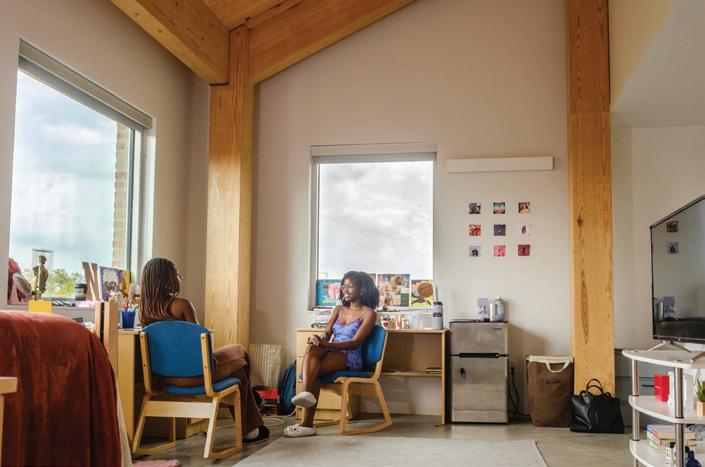
“For the administration, it has been very useful to see firsthand the quality of spaces that you can create in this way,” Vassallo said. “Rice has a tradition of having a campus that is an arboretum. Suddenly, the university understands that this is an asset. I think this is going to be one of the things that will reshape our identity and how we look forward as a university.”
Although I’m only here for my final semester at Rice, I’m excited for future Hanszenites to find a similar comfort in their new homes and begin to forge a new college culture to carry on our motto, “Hanszen Family Heart.”
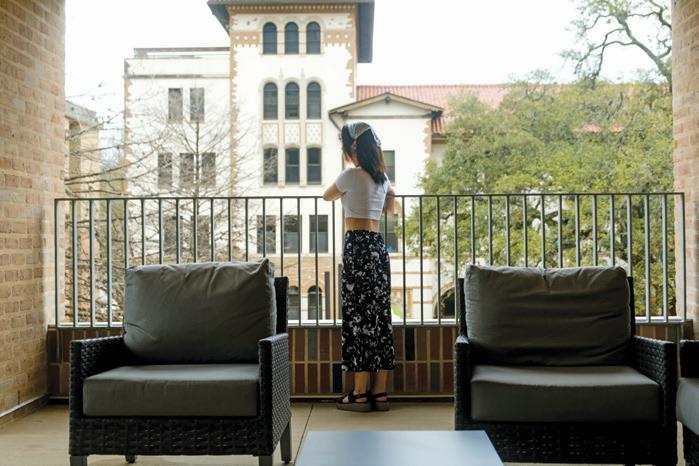 — MABEL TANG ’23
— MABEL TANG ’23
Construction of the landmark five-story Ralph S. O’Connor Building for Engineering and Science is nearing completion. The building’s facilities and programmatic mission will address a host of global challenges like clean water, renewable energy and access to health care. Home to the Welch Institute, it will house a prototyping facility that provides a hub for accelerating new technologies. The building’s capacity for research and collaboration, alongside state-ofthe-art classrooms and makerspaces, will offer more networking, hands-on experiences and experiential learning opportunities for Rice students. The labs are expected to be placed and the building officially open in late summer 2023.
SALLYPORT MAGAZINE.RICE.EDU 13
Best friends Temilade Dada ’23 and Nana MensahBonsu ’23 enjoy one last semester at Rice in their shared double room.
The author, Mabel Tang ’23, on one of the terraces overlooking the old Hanszen wing.
The Baldwin Grand
The student center provides an open invitation to sit and play a spell.
HOME TO RICE Coffeehouse, the campus bookstore, Willy’s Pub and KTRU Radio, the Rice Memorial Center also houses a piano that has enticed trained and novice players to tickle the ivories for more than 60 years. Since the RMC’s opening in 1958, a Baldwin grand piano has enriched the space outside of the Grand Hall, serving as a tribute to Lee Chatham, Rice’s band director from 1922 to 1937. Given by four of his closest friends, the gift was made to remind students then and now of Chatham’s love of music and the personal relationships he forged as the leader of the band. Chatham, known for his enthusiastic and cheerful disposition, also led Lee’s Owls, a beloved orchestra that provided dance music at annual campus events in the 1920s.
While campus traditions have changed over the years, the opportunity for students to express their artistic talents hasn’t. Any given day, passersby might hear an upbeat show tune, the strains of a melodic piano concerto or a beginner playing their variation of “Chopsticks.” For many, like Joseph Asfouri ’23, an electrical engineering and neuroscience major, the now well-played piano is a frequent stop between classes. “What keeps me coming back to play are the new people I meet every time,” Asfouri said, “either pianists themselves or classical music lovers who walk up and ask me to play a certain piece or who start a conversation about their connection to the music.”
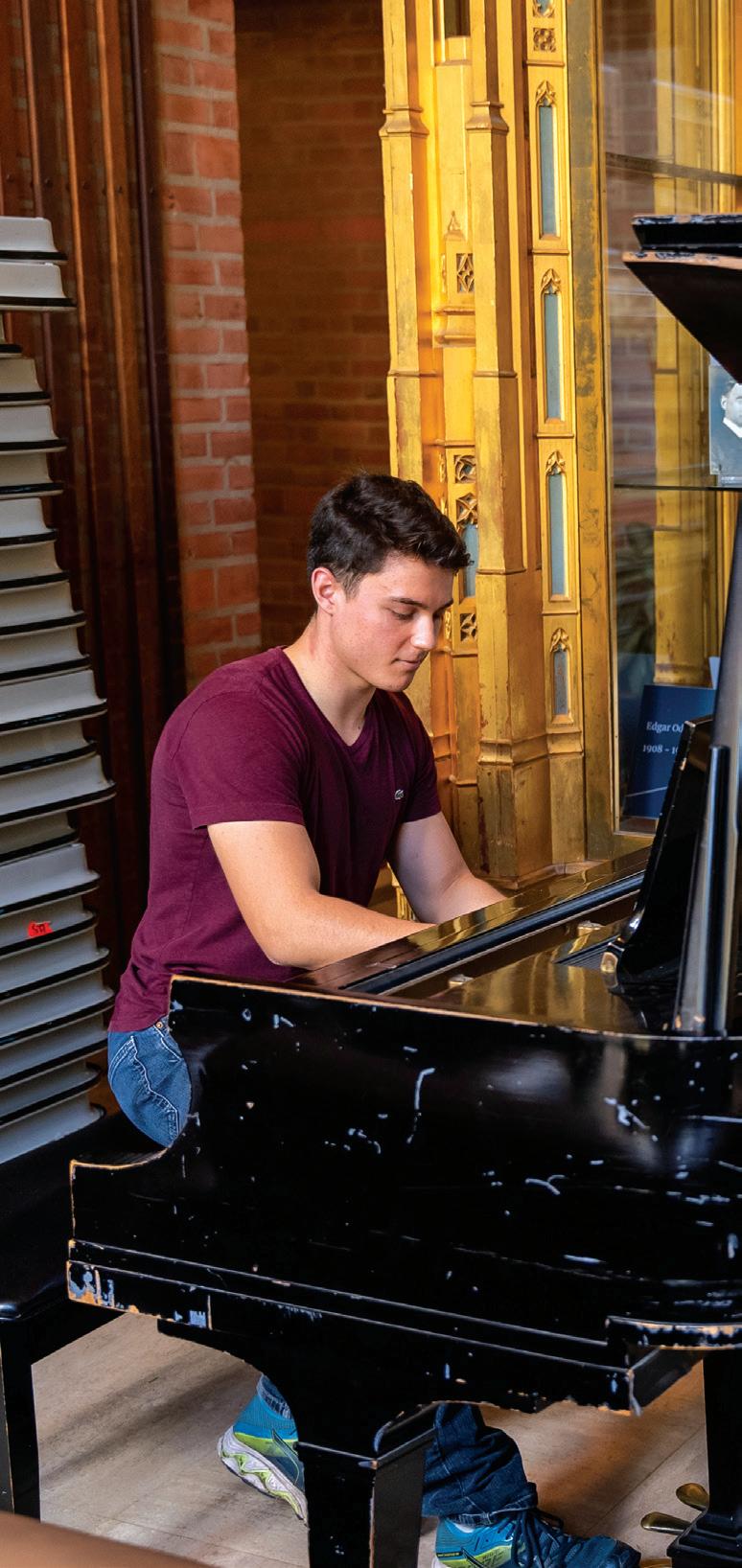 — TRACEY RHOADES
— TRACEY RHOADES
See more at magazine.rice.edu.
SALLYPORT 14 RICE MAGAZINE SPRING 2023
SPACES
PHOTO BY BRANDON MARTIN

BEHIND THE SCENES
Food, Finances and Friendliness
really important,” he said. Yuen came to the U.S. from Hong Kong to earn his degree in hotel and restaurant management at the University of Houston. In 2011, Yuen began his career with H&D, where he has been honored for his outstanding work at Cohen House as well as his volunteer outreach to Rice’s Chinese student community. He earned his MBA from Rice’s Jones Graduate School of Business in 2020.
support each project, so it involves a lot of communication with other departments, like Rice Management Company and finance and administration. A big part of the job is communication — with our executive chefs, our managers and our staff — and I frequently correspond with students and parents about billing and our meal plan. Right now, the focus is on food costs due to inflation, something I have concentrated on since I started this new position.
Where do you spend most of your time on campus?
If I don’t need to be in the office, I try to spend every minute walking around campus, especially during lunchtime. I monitor the dining services — for example, Brochstein Pavilion, the student center and Cohen House — to make sure our staff, customers, students and faculty are having a good experience. Since faculty members spend a lot of time with students, I ask them what students are asking for — if they need more latenight meals or other options. If I walk from Hanszen to Brochstein Pavilion, I am able to meet with a lot of people.
How has H&D responded to Rice’s growing and more diverse student population?
AS BUSINESS DIRECTOR OF Housing and Dining (H&D), Kevin Yuen ’20 believes that communication is key to everything he does at the university. “We work with a lot of people, and we are results-driven. The interconnections with people are
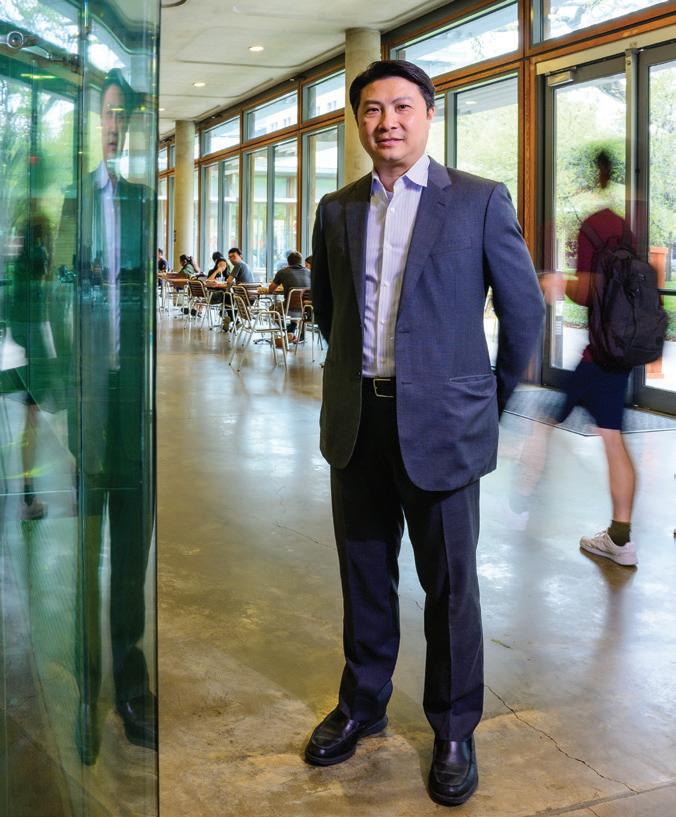
You were promoted to business director last year — what are your day-to-day responsibilities now? In our department, we’re always crosstraining, doing multiple things and learning a lot. I’m responsible for all the financial activity in H&D. We support the residential college projects, like the new Hanszen wing, as well as any work on magisters’ houses and graduate student housing. I analyze the project costs so we can establish their budgets. I also try to find a funding source to
We want all students to have a feeling of home food from their country. We are going to work on having more global cuisines at each servery, like Mediterranean, Indian and Asian options. One of the first new concepts we established was at the North Servery: Wok on Sunset. It’s been quite successful, and we’ll continue to carry on new concepts in other serveries.
Tell us about your life outside the hedges.
Family is one of my biggest focuses. My daughters are 7 and 12. My wife and I enjoy traveling with them. Last winter break, I took my family back to Hong Kong to experience Asia. Besides traveling, my main goal is to keep learning — it’s a never-ending journey to me.
— JENNY WEST ROZELLE ’00
16 RICE MAGAZINE SPRING 2023 PHOTO BY JEFF FITLOW
Kevin Yuen keeps Rice’s Housing and Dining services on budget and focused on the community they serve.
The Appearance of Trust
An experiment challenges our ability to judge a book by its cover.
 BY AMY MCCAIG
BY AMY MCCAIG
ILLUSTRATION BY MIGUEL PORLAN MAGAZINE.RICE.EDU 17 INNOVATION IN THE LAB, THE FIELD AND THE CLASSROOM WISDOM
STATISTICS
HANDING OVER THE car keys to a parking attendant. Selling and buying items online.
Driving through busy intersections — or taking turns at a fourway stop. Many daily, yet consequential, actions depend on one stranger trusting another, said Rick Wilson, the Herbert S. Autrey Professor of Political Science and professor of statistics and psychology. But what is such trust based upon — and how accurate are our decisions around trust?
Wilson and co-author Catherine Eckel, a Texas A&M University economist, recently published their findings on whether individuals can accurately predict trustworthiness based on personal appearance alone. In the paper, which appeared in the journal Political Behavior, Wilson and Eckel introduce their findings with an epic example of misplaced trust on a global political scale.
“In 2001, George W. Bush proclaimed that he looked into Vladimir Putin’s eyes and found the Russian leader to be ‘trustworthy.’ Many people claim
to be able to read their counterparts in bargaining settings; there is little doubt that this would be a valuable skill. … How often do they get it right?”
As it turns out, the authors found that making accurate surface judgments about trustworthiness in another individual is almost impossible. Building on data collected from a prior trust experiment, Wilson and Eckel asked participants to view photographs of the previous study’s subjects and, without any additional context or information, predict the trustworthiness of their decisions. The researchers also added a monetary incentive — correct guesses would be rewarded. It didn’t help. “While people are confident in their ability to quickly read the faces of others, they rarely do better than chance.”
Worse, the authors “found that subjects were influenced by stereotypes based on the features seen in the photos, including gender, skin color or attractiveness,” which means that relying on stereotypes in snap judgments around trust can end up reinforcing those stereotypes and lead to costly mistakes.
HUMANITIES FACULTY AWARDED NEH GRANTS
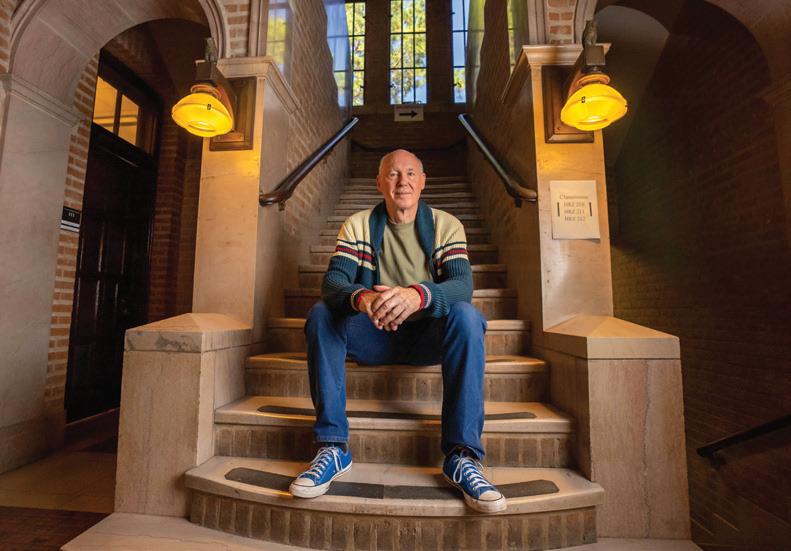
Musicologist
Danielle WardGriffin and historian Daniel Domingues da Silva are among the 204 recipients of grants totaling $28.1 million from the National Endowment for the Humanities. Ward-Griffin’s fellowship will support the completion of her book, “Televising Opera: Broadcasting and Performance in Anglo-American Culture (1945–75),” under contract with Oxford University Press. Domingues’ fellowship will focus on expanding the geographic coverage of SlaveVoyages, a collaborative digital initiative that compiles and makes public records of the largest slave trades in history. — AMY
MCCAIG
WISDOM 18 RICE MAGAZINE SPRING 2023
PHOTO BY GUSTAVO RASKOSKY
Rick Wilson
Cool Respite With a Conscience
An architect, an engineer and a composer walk into Post Houston, hoping to create an oasis.
RICE ARCHITECT Juan José Castellón, engineer Qilin Li and composer Kurt Stallmann brought their work “Building Ecologies” from the other side of the world to Post Houston as part of its sustainability event, “There Is Only One Earth.” The installation is a proof of concept for what the team hopes to build at Rice and elsewhere.
“The whole point of this project is to integrate architectural and structural questions with environmental questions,” Castellón said.
The concept prototyped at Post Houston is circular, though not physically. Designed to be placed on a rooftop, it is intended to not only
revive the spirits of those who pause beneath its shade but also make use of its environment by purifying and recycling rainwater for plants within and near the structure.
Taking root in Castellón’s fall 2020 studio at Rice Architecture, the structure was initially built thousands of miles away for the 2021 Biennale of Architecture and Urbanism in Seoul, South Korea. The prize-winning design was later combined with Li’s groundbreaking solar-powered desalination technology as part of Rice’s Center for Nanotechnology Enabled Water Treatment (NEWT).
When outdoors, the sloping overhead membrane shades will collect and filter water for reuse, as conceived by Li. The membranes are treated with nanoparticles to destroy microbes that might otherwise foul water that flows through the columns into storage located under the raised floor.
“This overcomes the usual problems related to storing rainwater in a cistern by avoiding microbial growth and allowing for post-treatment of the water,” Li said.
Though water doesn’t flow at this installation, visitors sense it thanks to Stallmann, a professor at Rice’s
Shepherd School of Music. Stallmann encountered Castellón’s virtual reality installation at the Moody Center for the Arts, and their shared interest led to a conversation about the Post Houston project. “He came to my office to look at the hollow columns we fabricated in Barcelona [to support the structure] and said, ‘You know, this could be an instrument,’” Castellón said.
At Post Houston, hanging speakers feed the synthesized sound of rain into the ceramic columns, bringing the installation to life. “If one listens, they can hear different types of falling water sounds above the canopy,” Stallmann said. “Some droplets seem to hit the canvas, making a percussive sound; others seem to pool into small rivulets and fall into the resonating pipes.”
Stallmann also concealed transducers in the floor to vibrate the lower part of the structure, explaining that visitors “can feel a subtle vibration through their feet, and if they touch the columns, they can feel the column vibrating in a way that indicates [the motion of water] inside the structure.”
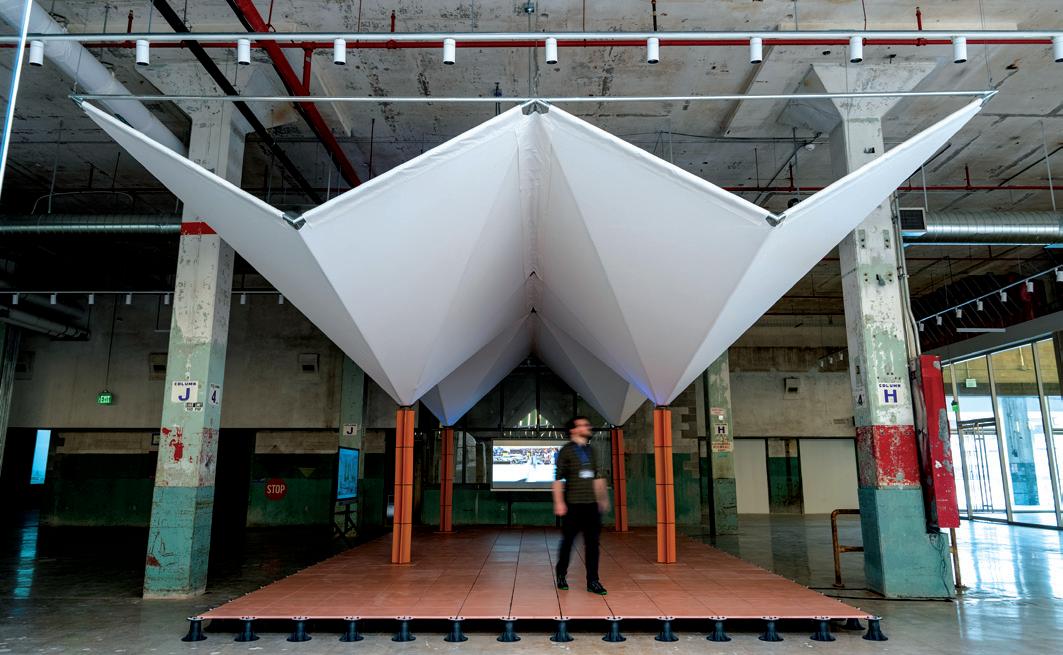
Post Houston is hosting the installation in a gallery near the main lobby until April 20, 2023. —
MIKE WILLIAMS
PHOTO
BRANDON MARTIN MAGAZINE.RICE.EDU 19
BY
ECOLOGY
ENGINEERING
The Explainer
What’s behind the heated debate over the safety of gas stoves?
BY DANIEL COHAN
GAS STOVES EMIT ONLY A

tiny share of the greenhouse gases that warm the climate, but they have long assumed a heated role in climate politics. The debate reignited in January, when a member of the U.S. Consumer Product Safety Commission told Bloomberg News that the agency planned to consider regulating gas stoves due to concerns about their health effects.
Politicians reacted with overheated outrage, putting gas stove ownership
on a par with the right to bear arms and religious freedom. CPSC Chair Alexander Hoehn-Saric tried to douse the uproar, stating that he was “not looking to ban gas stoves” and that his agency “has no proceeding to do so.”
Gas stoves are a leading indoor source of nitrogen dioxide, or NO₂, which can cause or worsen respiratory illnesses in people who are exposed to it. Scientific studies show that living in a home with a gas stove increases children’s risk of asthma by nearly one-third, and some experts say health risks from gas stoves could be comparable to living with a smoker.
But the skirmish reveals important contours of the battlefield on which climate politics are waged. Gas stoves matter to the climate and to the gas industry because they serve as gateway appliances to the dominant residential uses of natural gas: heating and hot water.
The significance of gas stoves for the climate becomes clearer in the context of the Biden administration’s goal of achieving net-zero U.S. greenhouse gas emissions by 2050. This target can only be achieved by curbing fossil fuel use across the economy, including in homes.
If new homes are built fully electric from the start, they avoid the cost of installing natural gas hookups and emit far less air pollution and fewer greenhouse gases throughout the homes’ lifetime. New York City and more than 50 California towns, cities and counties have already banned gas hookups in new buildings.
Elsewhere, however, 20 states have barred the enactment of natural gas bans, and gas stoves are a big reason why. “Cooking is the hill that the gas industry wants to fight on,” Bruce Nilles of Climate Imperative told me in a 2020 interview that foreshadowed the current skirmish. The American Gas Association has promoted the notion that gas stoves make skilled cooks since the 1930s, when it introduced the advertising slogan “Now you’re cooking with gas.” An AGA executive planted the phrase with writers for comedian Bob Hope. Soon it was picked up by comedian Jack Benny and even by Daffy Duck.
Today, however, many chefs, consumers and experts say gas is no longer the obvious choice. Magnetic induction cooktops, which cook using electricity to generate a magnetic field, heat faster, control temperatures more precisely and use less energy than other stoves. Homes built today will endure far beyond Biden’s 2050 net-zero target. And the longer the gas-is-better myth persists, the harder it will be to fully electrify new homes from the start.
Daniel Cohan is an associate professor in the Department of Civil and Environmental Engineering and most recently the author of “Confronting Climate Gridlock: How Diplomacy, Technology, and Policy Can Unlock a Clean Energy Future.” This article is republished from The Conversation under a Creative Commons license.
WISDOM 20 RICE MAGAZINE SPRING 2023 ILLUSTRATION BY ALEX EBEN MEYER
Rocky Landing
Sonic booms and a fireball led Linda Welzenbach Fries to four meteorites.
THE LAST OF THREE February fireballs seen around the world, falling on back-to-back days, was accompanied by a series of sonic booms in the skies over South Texas. The next morning, Feb. 16, the Next Generation Weather Radar system of the National Oceanic and Atmospheric Administration (NOAA) recorded falling materials, and a preliminary report posted on the NASA website showed evidence that meteorites might have made it to the ground.
Linda Welzenbach Fries, a meteorite expert and science writer in Rice’s Department of Earth, Environmental and Planetary Sciences and the former meteorite collections manager at the Smithsonian Institution, leaped into action. Within hours, she began the 350-mile drive to the area in the Rio Grande Valley where the sonic booms had sounded.
She was accompanied by Marc Fries, her husband and a planetary scientist at NASA Johnson Space Center’s Astromaterials Research and Exploration Science Division, as well as the manager of Meteorite Falls, a NASA website that uses weather radar imagery to plot projected landing sites.
During the Fries’ long drive, additional resources came in: videos, wind information, and more data from NASA and NOAA. “As it turns out,” Welzenbach Fries explained in a blog post
detailing the discovery, “the altitude and speed were not typical.” Most asteroids and meteoroids intersect Earth at up to 72 kilometers per second, whereas this space rock was moving at closer to 9–12 kilometers per second, and it survived to a lower level in the atmosphere. It may have been this unusual approach that caused the sonic booms to be “strong and widespread,” she wrote.
Another factor might have been the object’s material. “Stoney materials tend to fail and explode from forces exerted on the leading edge of the object,” she wrote, and “this is what happened to the object in South Texas.”

Upon arriving, the Fries spoke to the landowner of the impact area, who consented to their search and agreed to donate one of the fragments to a scientific collection. Their hard work paid off: The Fries discovered three “fully fusion-crusted” meteorites and one fragment, all believed to have been part of a meteoroid that weighed an estimated 1,100 pounds prior to breaking apart in Earth’s atmosphere. “Fusion crust is the residual melted rock that ‘fuses’ to the surface of the rock, analogous to the glaze on pottery,” Welzenbach Fries explained.
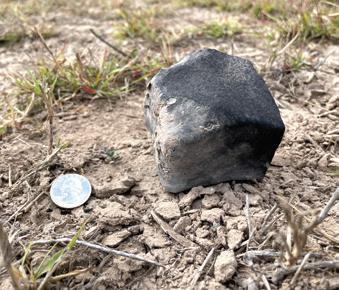
A fourth fragment was found late Feb. 18; this piece “is a light gray color that sparkles from the finely disseminated metal grains spread throughout” and has been brought to Rice for analysis and classification.
As Welzenbach Fries wrote, “Study of asteroid remnants such as these enhance our understanding of the origin and evolution of our solar system.”
MAGAZINE.RICE.EDU 21
SPACE
— HILARY C. RITZ
Below: Linda Welzenbach Fries with the first meteorite found. Above: The third stone (756 grams), found Sunday, Feb. 18.
PHOTOS BY LINDA WELZENBACH FRIES
BIOENGINEERING
How Fungi Spill Their Secrets
AS ANYONE WHO HAS EVER attended a cocktail party can tell you, shedding inhibitions makes you more talkative and possibly more prone to divulging secrets. Fungi, it turns out, are no different from humans in this respect.

Using an approach that simultaneously modifies multiple sites in fungal genomes, biomolecular engineer Xue “Sherry” Gao and her collaborators coax fungi into revealing their best-kept secrets, potentially ramping up the pace of new drug discovery. It is the first time that the technique, called multiplex base editing (MBE), has been used as a tool for mining fungal genomes for medically useful compounds (think: penicillin). Compared to single-gene editing, MBE reduces the research timeline by over 80% in equivalent experimental settings, from an estimated three months to roughly two weeks.
Base editing refers to the use of CRISPR-based gene editing tools in order to modify a rung in the spiral ladder of DNA known as a base pair. Previously, gene modifications using base editing had to be carried out one
at a time, making the research process more time-consuming. “We created a new machinery that enables base editing to work on multiple genomic sites, hence the ‘multiplex,’” Gao said. Using MBE, the Gao lab induced fungi to produce significantly more natural compounds, including some previously unknown to the scientific community. “To me, the fungal genome is a treasure,” Gao said, referring to the significant medical potential of fungi-derived compounds. “However, under most circumstances, fungi ‘keep to themselves’ in the laboratory and don’t produce the bioactive small molecules we are looking for.” Enabled by MBE, her team can easily delete several of the regulatory genes that “make the biosynthetic machinery silent.” Disinhibited, the engineered fungal strains produce more bioactive molecules, each with their own distinct chemical profiles. “These compounds could be useful antibiotics or anticancer drugs,” Gao said.
— SILVIA CERNEA CLARK
Xue “Sherry” Gao is the Ted N. Law Assistant Professor of Chemical and Biomolecular Engineering and an assistant professor of bioengineering and chemistry. The study was published in the Journal of the American Chemical Society.
Read more at magazine.rice.edu.
WISDOM 22 RICE MAGAZINE SPRING 2023 ILLUSTRATION BY SOL COTTI
A high-efficiency gene-editing tool may speed up the pace of new drug discovery.
Using an approach that simultaneously modifies multiple sites in fungal genomes, biomolecular engineer Xue “Sherry” Gao and her collaborators coax fungi into revealing their best-kept secrets, potentially ramping up the pace of new drug discovery.
Pe ptides in Print BIOSCIENCE
A new ink for 3D printing promises bioengineering breakthroughs.
RESEARCHERS IN RICE’S Hartgerink lab have figured out how to 3D-print well-defined structures, such as lattices, using a peptide ink.

“Eventually, the goal is to print structures with cells and grow mature tissue in a petri dish. These tissues can then be transplanted to treat injuries or used to learn about how an illness works and to test drug candidates,” said Adam Farsheed ’24, a Rice bioengineering graduate student and lead author of the study, which appeared in Advanced Materials.
“There are 20 naturally occurring amino acids that make up proteins in the human body,” Farsheed explained. “Amino acids can be linked together into chains, like Lego blocks. When amino acid chains are shorter than 50 amino acids, they are called peptides.”
Jeffrey Hartgerink, professor of chem-
istry and bioengineering and associate chair for undergraduate studies, and his collaborators previously developed a class of self-assembling peptides, where “self-assembling” means they can arrange themselves solely based on their structure and composition. These “multidomain peptides” assemble into a hydrogel: a water-based material with a gelatinous texture that can be useful for a wide range of applications such as tissue engineering, soft robotics and wastewater treatment.
Multidomain peptides have been used for nerve regeneration, cancer treatment and wound healing and have been shown to promote high levels of
cell infiltration and tissue development when implanted in living organisms.
“What I was looking to do in this project was to show that these peptides are a great 3D-printing ink,” Farsheed said. “It might be counterintuitive since our material is so soft, but I recognized that our multidomain peptides are an ideal ink candidate because of the way they can reassemble after being deformed, similar to how toothpaste forms a nice fiber when pushed out of a tube.”
Farsheed’s mechanical engineering background inspired an unconventional approach to testing his hypothesis.
“Instead of chemically modifying the material to make it more amenable to 3D printing, I tested to see what would happen if I simply added more material,” he said. “I increased the concentration about fourfold, and it worked extremely well.
“There have been only a handful of attempts to 3D-print using other selfassembling peptides, and that work is all great,” Farsheed said, “but this is the first time that any self-assembling peptide system has been used to successfully 3D-print such complex structures.” – SILVIA
MAGAZINE.RICE.EDU 23
CERNEA CLARK
Multidomain peptides have been used for nerve regeneration, cancer treatment and wound healing and have been shown to promote high levels of cell infiltration and tissue development when implanted in living organisms.
IMAGES COURTESY OF HARTGERINK LAB
Above: Structures printed using the peptide-based 3D-printing ink.
Now Reading
Losing the Precious Few How America Fails to Educate Its Minorities in Science and Engineering
Richard A. Tapia
Arte Público Press, 2022
RICHARD TAPIA’S parents emigrated from Mexico to Los Angeles as children in search of a better life. Forced to work in order to survive, they weren’t able to achieve their educational goals — but their children ultimately did. A longtime mathematics professor at Rice, Tapia is the first Latino to have won all three of the United States’ most prestigious science and engineering awards: the National Medal of Science, the National Science Board’s Vannevar Bush Award and the American Association for the Advancement of Science’s Public Engagement with Science Award. “In a nutshell, I have succeeded,” he writes. “Against all odds, and well beyond what anyone, including me … ever would have dreamed.”
Tapia’s success is, however, the exception that proves the rule. In “Losing the Precious Few,” he scrutinizes the factors that have excluded other minorities from STEM programs — particularly Native Americans, African Americans, Latinos and Pacific Islanders, who are so underrepresented in science and engineering that Tapia calls them the “Precious Few.” Their scarcity in STEM education and careers is harmful not only to racial justice but also to the economic and scientific health of the country, he argues — but the trend can be reversed. “Our goal should be to produce so many ‘precious few’ that eventually they will become ‘the precious many,’ and as a result contribute to the well-being of our country and our world.”
— JENNIFER LATSON
Soaking the Middle Class Suburban Inequality and Recovery from Disaster
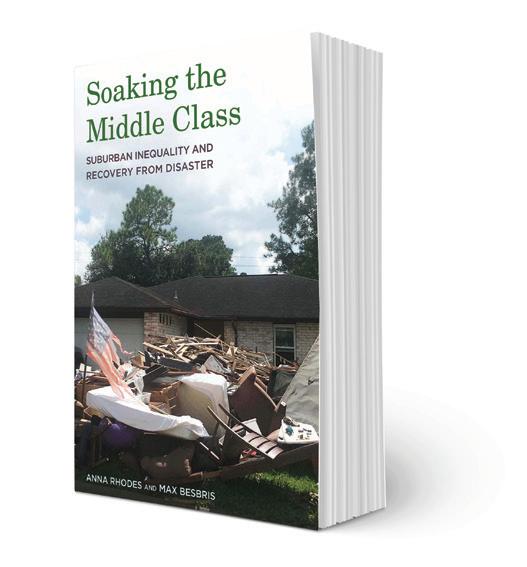 Anna Rhodes and Max Besbris
Anna Rhodes and Max Besbris
Russell Sage Foundation, 2022
A BOOK BY RICE sociologist Anna Rhodes and University of Wisconsin sociologist Max Besbris explores how families in the Houston suburb of Friendswood recovered from Hurricane Harvey and how that process exacerbated economic inequality within the community. After Harvey, many residents found it difficult to assess their future flood risk, partially because federal agencies and local governments offered them little or no guidance. Without a clear sense of risk, most of them decided to return to their potentially vulnerable neighborhoods and rebuild. Ultimately, the inequalities amplified by the recovery process make middle-class suburbs less resilient at a time when climate change makes them more vulnerable. “Extreme weather is only growing in scale and severity as global warming worsens,” Rhodes said. “We hope this book will shed light on how even well-resourced neighborhoods are increasingly at risk as climate-related storms intensify.”
— AMY MCCAIG

WISDOM 24 RICE MAGAZINE SPRING 2023
FACULTY BOOKS
System of Novelties
Dawn Finley and Mark Wamble Park Books, 2022
New Housing Paradigms in Mexico
 Edited by Jesús
Vassallo and Sebastián
Edited by Jesús
Vassallo and Sebastián
López Cardozo
Park Books, 2022
For more than 60 years, since its publication of William W. Caudill’s “On People and Things” in 1961, the “Architecture at Rice” book series has produced titles that illuminate the current cultural moment and tackle some of the most pressing issues facing architects, designers, developers, housing advocates and urban planners. In “Nueva Vivienda,” Jesús Vassallo, an associate professor at the Rice School of Architecture, and Sebastián López Cardozo ’22, a recent graduate, follow in that scholarly tradition, exploring the ways in which Mexican architects are addressing economic, cultural and environmental concerns through innovative housing design.
The book features 22 Mexican housing projects from the past 10 years, along with essays examining how these projects are breaking new architectural ground — and how architects in the U.S. and other nations could adapt them to resolve housing issues in their own communities. As the editors write, “In the context of a global housing crisis, the energy devoted by these architects to imagining denser, more vibrant urban centers for the middle classes deserves serious consideration and serves as an inspiration for those of us who regard the design of housing as a form of public service.” — J.L.
Another new release in the “Architecture at Rice” series, “System of Novelties” chronicles two decades of work by the Houston-based Interloop—Architecture, founded in 2001 by Rice School of Architecture professors Dawn Finley ’99 and Mark Wamble. The book features 11 of the firm’s projects, ranging from single-family homes and cultural institutions to a light rail platform and a reimagining of the humble but monumentally important exit sign. One project was an open-air building to house “Tending (Blue),” an artwork in James Turrell’s “Skyspace” series, which also includes his “Twilight Epiphany” Skyspace on the Rice campus. Another was a campground complex in Lake Texoma, Texas, built on a peninsula that periodically floods so severely that more than two-thirds of the site disappears underwater. Each of the firm’s commissions brought its own distinct challenges, and each design represented an array of innovative solutions. “At the macro level, our design work is a collection of idiosyncratic projects that range in scale, type and complexity,” the architects write. “Examined at the micro level, each project reveals a unique set of circumstances, constraints and constituents.” — J.L.

WISDOM MAGAZINE.RICE.EDU 25
Nueva Vivienda
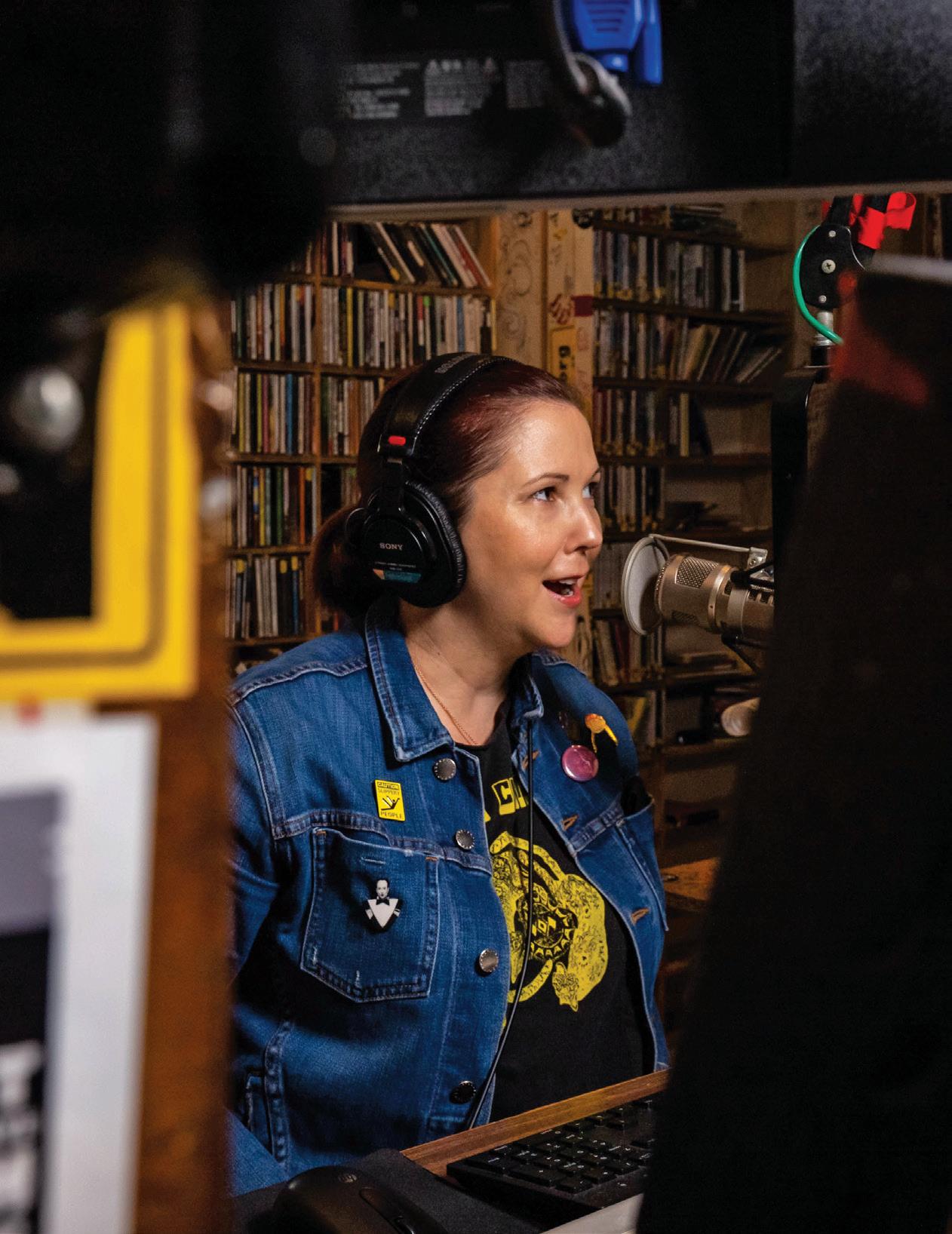 Community DJ Ashley Turner hosts the show “Afternoon Delight” with longtime friend Nicole Buergers.
Community DJ Ashley Turner hosts the show “Afternoon Delight” with longtime friend Nicole Buergers.
Five decades of KTRU DJs are linked by their love of the music and a unique archive of thousands of music reviews


tucked among the stacks.
BY JOE NICK PATOSKI
BY GUSTAVO RASKOSKY
PHOTOS
The control room of KTRU Rice Radio has a welllived-in look. Shelves of compact discs surround the room’s desk and main microphone. All of the walls are plastered with yellow-and-black KTRU bumper stickers, along with graffiti and other ephemera, mostly identifying bands and record labels. Within reach of the on-air disc jockey are two video screens and bays to play CDs, cassettes and digital audio, with two turntables for vinyl records on either side. Additional microphones and chairs for guests are set up opposite the main mic.

This uniquely cluttered space is ground zero for some of the wildest music heard on Houston airwaves and online. And for the DJs — mostly Rice students — it’s where they’re having the most fun while pursuing their studies.
The woman talking animatedly into the main microphone, with headphones covering her curly mane, is Katharine Shilcutt, the director of student media at Rice and also a DJ. She squints close at one of the turntables as she tries to cue up a track from a clear vinyl album. Once the track begins to play, she swings around her chair in search of a 1970s vintage album by The Roches.
Being a DJ is what KTRU is all about; there are 150 of them at the station. “Rice University does not
28 RICE MAGAZINE SPRING 2023
Director of Student Media
Katharine Shilcutt hosts a show that often features her favorite band, The Roches.
have a radio-television-film department,” Shilcutt says. “This place is most definitely not a springboard to a career in broadcasting. We’re not training these people how to be professionals. This is just where you come when you care about music. It’s the students teaching themselves and finding a spot to express themselves.”
GLORIOUS CHAOS
The sounds of KTRU range from the expected eclectic college-station mix of jazz, world, classical, reggae, roots and local bands to the arcane, obscure and underserved. KTRU’s weekly schedule includes “C-Pop,” featuring pop music from China; “Gaytru,” specializing in LGBTQ+ music; “Mutant Hardcore Flower Hour,” showcasing punk rock; “Roots d’Afrique” with music from Africa; “Genetic Memory,” airing the music subgenre known as Noise; and “Löded Diaper,” dedicated to teen angst garage rock.
Keegan Pierce ’24, a physics major with a minor in philosophy, works the 1 p.m. hour at KTRU on Thursdays, playing accordion music from Texas and Louisiana, mixing conjunto with zydeco and Cajun. “I went to a lot of live
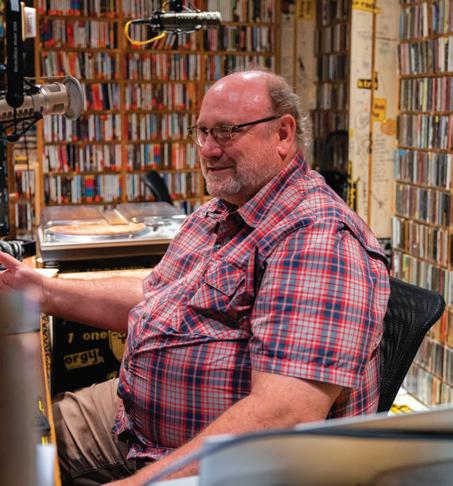
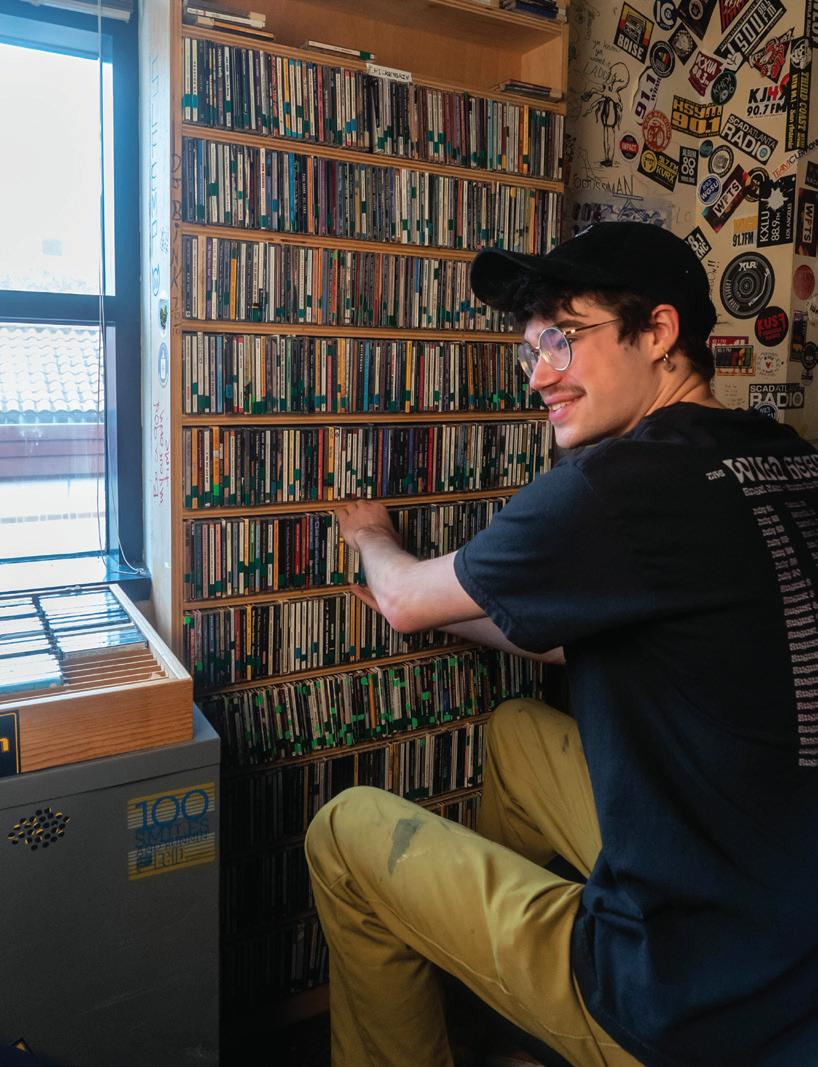
music with my dad when I was in high school [in Birdville near Fort Worth] and went to Deep Ellum a lot,” he says while a song plays over the air. “My freshman year, I sent him a request for zydeco music.” After segueing from a vinyl recording by Santiago Jiménez Jr. to an album track by Clifton Chenier, he explains that his KTRU experience has prompted him to refine his academic focus to acoustic engineering — working with sound.
Imogen Brown ’25, host of “Babewaves,” which focuses on music by women, femme and noncisgender artists, also testifies about the power of KTRU. Brown, who’s majoring in the study of women, gender and sexuality, joined the station because she loves to create, share and discover music. “Doing radio and being on air is a whole other entity that I’ve learned about along the way,” she says. “It means reaching people whom I don’t know and have never seen, and that’s terrifying and also exciting. It also means my family at home in New York is listening to me. My parents are staying up past their bedtime to tune in.”
Student DJ Keegan Pierce ’24 plays accordion music from Texas and Louisiana, mixing conjunto with zydeco and Cajun.
Community DJ Christopher Spadone has hosted the Roots d’Afrique show since 2008.
Overnights, KTRU goes “robo,” airing music preprogrammed by the station’s chief engineer Ross Cooper and various students to reflect the breadth of what’s heard on live shows. Over the course of one sample hour, the mix ranges from South Asian and Chinese music and experimental jazz to Appalachian music and psychedelic rock.
At 3 a.m. on most weekdays, though, KTRU goes live for an hour with Matthew Bitz ’25, a chemistry major who goes from his shift at the station to open a Starbucks nearby at 4:30. “I play mostly jazz to create a calm atmosphere, not super out-there jazz. Houston has a great jazz history, and I like to explore that.”
Bitz has an audience too. “My shift supervisor at Starbucks listens, and we talk about what I played when I get there. I know people listen if they’re studying at Sid Rich, my residential college.”
KTRU fills an important hole for Bitz. “When I was in high school, my entire life was all about music,” he says. “I play violin and piano. I’d get up every morning at 6 to go to band practice and stay after school to do orchestra. When I came to Rice, I wasn’t doing music anymore. It was all chemistry science-y stuff. The opportunity to get back into music in this kind of way has been really enjoyable. I’d like to stay involved with radio in a small way, like the DJs here.”
In addition to the students, regular folks in Houston host shows too. One example is a specialty show called “Afternoon Delight.”
Community DJs Nicole Buergers and Ashley Turner, respectively a professional beekeeper and voice-over artist, get together every Tuesday and play two solid hours of 1970s soft rock.

Because, why not?
Back in the early 1980s when I first tuned in, KTRU played music I didn’t hear anywhere else. Tuning in was always a discovery. Forty years later, things sound the same as they ever did — cutting edge, proudly eclectic, wonderfully chaotic and somewhat subversive.
RESILIENT RADIO
There have been some significant skips along the way, including the Rice administration’s sale of the 91.7 frequency signal in 2011 followed by a long spell as an online-only station. In 2019, KTRU reemerged on air as a low-power FM signal on 96.1 and continues to stream online at ktru.org. The pandemic also took away a critical piece of KTRU’s programming: the live in-studio performance. KTRU returned to presenting live, over-the-air music in October 2022 with a concert by Katherine Wu ’23, a pre-med and neuroscience major who is also training to compete in archery in the Olympics. Wu played the Chinese guzheng, aka the Chinese table harp.
While those issues are behind them, there’s another challenge ahead. In the coming year, the entire student center will be demolished to make room for construction of the new 80,000-square-foot Moody Center for Student Life and Opportunity. The current offices on the second floor of the Ley Student Center, KTRU’s home for the past
30 RICE MAGAZINE SPRING 2023
KTRU business manager Soleste Starr ’25 holds a copy of the CD “Solely” by Natalie Jane Hall.
36 years, will move across campus into a temporary space.
When Shilcutt was appointed student media director in March 2022, a position that includes oversight of the Rice Thresher newspaper and Campanile yearbook, she started taking inventory around KTRU in anticipation of the coming move. A half-century dedicated to all kinds of music has built up the “stacks” at the station to more than 200,000 pieces of music, according to Cooper. That translates into tens of thousands of vinyl albums and compact discs as well as cassettes and tape carts — all of which will need to be moved twice.
In the process of taking inventory of the stacks, however, Shilcutt discovered the secret sauce that separates KTRU from everywhere else: the music reviews.
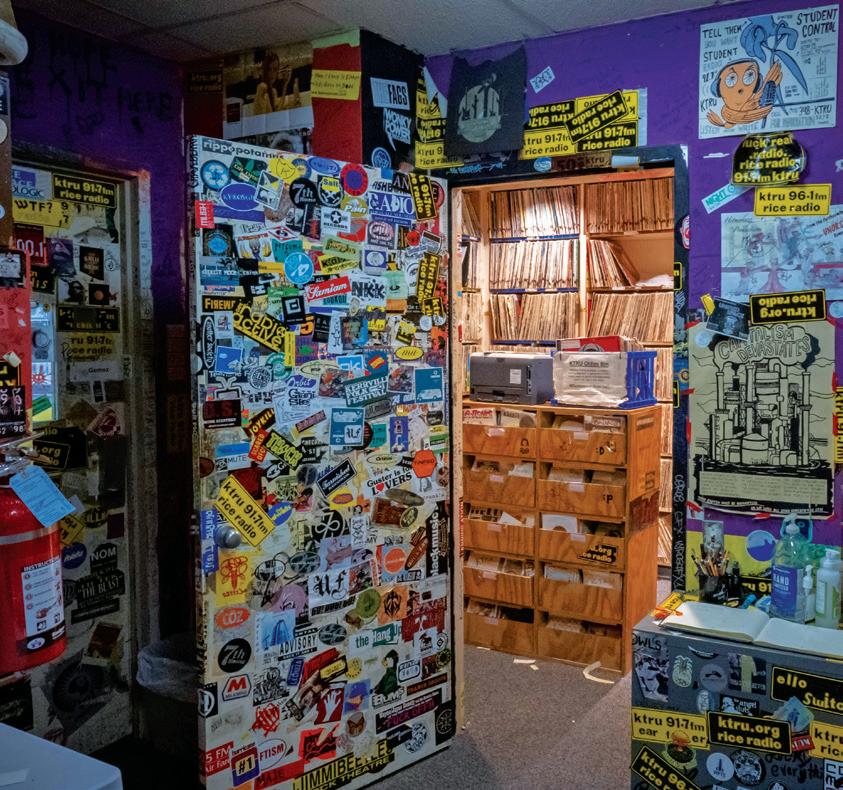
OBSESSIVE NERDINESS
One of the few rules at KTRU is that each piece of music aired must be accompanied by a review written by a KTRU DJ to provide insight and guidance to other DJs.

Conner Clifton, assistant director of student media, showed me what used to be the newsroom studio to point out several stacks of a hundred CDs each waiting to be reviewed in order to be played.
A pleasant mid-tempo number, not a strong opener, but indicates the tonal medium of this album.
— Anon, on opening song, “More Than This,” on “Avalon” by Roxy Music, 1982
So what makes a good Surfers album great?
(1) Semi-s---ty production that makes everything sound as if drawn through a rusty sieve.
Every DJ at KTRU is required to write at least one review. “I thought they were so weird, funny and different,” Shilcutt says. “There were these bizarre non sequiturs that have nothing to do with the album: ‘Once I saw Eraserhead twice in two nights and to this day, I don’t know why I did that.’ That’s a review of Julee Cruise, ‘Floating Into the Night.’ Yes, it’s a David Lynch collaboration, but —” Reviews have been part of the KTRU experience since the station appeared on the FM airwaves in May 1971.
— HK, on “piouhgd” by the Butthole Surfers, 1991
The station’s debut coincided with the golden era of music criticism. Before then, music reviews were limited to pithy comments about records (“It’s got a beat, and you can dance to it”) made in trade publications. Criticism in newspapers and magazines, if published at all, was restricted to classical music and jazz.

But in the late 1960s and early 1970s, college newspapers and consumer music magazines such as Rolling Stone, Creem and Crawdaddy started taking popular music seriously and birthed rock criticism. Reviews of music often became as important and entertaining as the music itself. Critics such as Ellen Willis, Greil Marcus, Peter Guralnick, Ed Ward, Lester Bangs and Nick Tosches became recognized as serious writers, not just rock critics.
KTRU reviews reflect those times and carry the tradition to the present. Taken as a whole, the reviews make up an informal anthology
MAGAZINE.RICE.EDU 31
KTRU’s vinyl stacks room holds thousands of records and a turntable for private listening.
of modern music as told by Rice students and community members who happen to be armed with microphones and access to all the music they can imagine.
Dr. Frank, who wrote all but one of the songs on this album, showcases the benefit of a 1590 SAT score when used properly in the name of pop punk.
— Melissa J., on “Love Is Dead” by the Mr. T Experience, 1996
The reviews are generally curt, wordy, intelligent and passionate. Brown, the “Babewaves” host, is an avid reader of reviews. “The reviews are pretty descriptive and creative,” she says. “They make comparisons I sometimes don’t understand, but usually, a review gives me a good idea what vibe the song is before I listen to it and where it will fit in a set. It’s insane I can pull a review off the shelf from 1985 and someone is giving their opinion from that time. It’s a piece of history.”
Writing reviews is hard, Brown adds. “It’s not that I don’t like doing it. It’s hard to critically think about every song. I write music reviews for The Thresher. Those are more ‘sit down and let everything out.’ One sentence has to feed into the next. You have to paint the album as a whole. KTRU [reviews] are conversational.”








“The reviews try to be as helpful as possible,” Shilcutt explains. “People want to leave their mark. People want to talk about this stuff. They want to talk about what makes a great Butthole Surfers album. ‘Here’s a list.’ Across time, DJs will argue with each other. They’ll add comments.”


Seem to be caught in the same style as “Remain in Light,” but without the esoteric (“Listening Wind”) type songs. Technically proficient. ... [The song “Swamp”] sounds like Byrne’s been taking hormones. Beat more prevalent.
— MFZAKES, on Talking Heads’
“Speaking in Tongues,” 1983
All in all, Band of Susans shows the signs of a wellpolished and professional band. However, they lacked a certain oomph to distinguish their music from a squeaky doorknob.
— Matt Tenny ’97, on “Here Comes Success” by Band of Susans, 2012
Bulls---. This is good s---.
As Kurt Cobain said, “[Jandek’s] not pretentious ... but only pretentious people like his music.”
— Corrin Fosmire ’21, on reclusive Houston recording artist Jandek’s album, “Houston Friday,” 2017
I actually hate this album.
Hard to believe such a gem comes from Merge. NMH [Neutral Milk Hotel] is mainly Jeff Mangum and is out of Ruston, Louisiana (maybe that’s why it is so good). Truly one of the best, if not the best, albums of ’96 and all of history.
— Ajda Snyder, “On Avery Island” by Neutral Milk Hotel, 1996
I was at this show, it was great. You gotta love the attitude.
Absolute shambolic mess from the former Big Star and Box Tops front man. Tracks have lots of mistakes, random stops and restarts, out-of-tune instruments and voices ... and it’s f---ing great. I double dog dare you to play it ... you might even end up loving it as much as the rest of its cult following.
— Anon, on “Like Flies on Sherbert” by Alex Chilton, 1980
32 RICE MAGAZINE SPRING 2023
The older the review, the more tempting it is to figure out whether the reviewer stood the test of time. Sleater-Kinney, an all-female Pacific Northwest indie band led by future Portlandia star Carrie Brownstein, issued their fifth album “All Hands on the Bad One” in 2000. At the time, their tilt toward the mainstream in the wake of fellow PNW indie Nirvana’s global success hit DJ Holly all wrong. “I fear this is the death knell for SK ... the spark is gone.” Holly was pretty much correct. SK made only two more albums before going on hiatus.
With critics like this, I’m hardly surprised when Clifton opens up another crowded storage room at KTRU and points past mic stands, pieces of a drum set and amps to a shelf of vinyl albums. “That’s the ‘Too Popular’ shelf,” he says. There are familiar artists and titles such as David Bowie, “Bob Dylan at Budokan” (“That review was harsh as hell,” Clifton says), John Lennon (enough already of “Imagine,” evidently), and “every Paul Simon and Simon and Garfunkel we ever had.”
Such opinions run strong. Written on the label of the album “Built for Speed” by the Stray Cats is the command, “Do Not Play #1!” The song title itself is marked out entirely by black marker. But it’s not too difficult to see the reference, which is, of course, “Rock This Town.”
Even King Crimson (!), Kinks, Byrds and Father
John Misty have been sidelined due to overexposure. Harry Styles and Taylor Swift never made it in to the stacks in the first place. But, Ray Charles! I shake my head. “This place is nerdy,” Pierce says. “Everyone takes their obsession to the next level. This is like playing a sport at other schools.”
This “difficult second album” ... may very well try the patience of current fans (although judging by the radiant postcoital afterglow among the online pundits, this may not be the case).

— HK and Nancy N., on “Ys” by
Joanna Newsom, 2007
What is Kraut rock? German proto-electronic minimalist rock, with a heavy focus on driving repetitive rhythm.
— Anon, on “2 Originals of Neu!” by
Neu!,


1972
TRUE INDEPENDENCE
At 11 a.m., Shilcutt wraps up her hourlong shift and yields the mic to Kelly Moore, the community DJ who hosts “Chickenskin,” a program focused on American roots music, and then heads downstairs for a meeting of KTRU’s board of directors, who are all student DJs. About 20 student board members graze through a buffet of Indian cuisine before getting down to the main topic: planning the upcoming outdoor show in April. This year’s show will be an all-Texas lineup of five bands. The punk band will close out the day, they agree, before moving on to festival logistics.
“This is just a nice place for students to gather and play music,” Shilcutt says. “The administration encourages them to do so and pretty much leaves them alone. People can play anything.”
Pierce, the accordion music DJ, agrees. “The radio is a creative outlet, something I enjoy. The place is a big part of the appeal. I love music and all of the stacks, all the reviews, the graffiti. I started organizing shows last year. When I get interviewed and asked about leadership, I cite setting up the outdoor live concert, being a stage manager, organizing meetings. I’ve been able to make cool things happen.
“KTRU, I don’t want to say they operate in a bubble,” Pierce says, “but they are generally unconcerned how other people do things. They want to do things their own way. That’s the Rice way. That’s the KTRU way.” ◆
See additional images and video for this story at magazine.rice.edu.
MAGAZINE.RICE.EDU 33
KTRU’s copy of “Built for Speed” by the Stray Cats with the command “Do Not Play #1!” written on the label.
Physician, Heal WorldThy
Vuong “Von” Nguyen, M.D., brings a wealth of experience to Google’s work on global climate and health issues.
By Alexander Gelfand

 Photos by Audra Melton
Physician Von Nguyen at Google headquarters in Atlanta
Photos by Audra Melton
Physician Von Nguyen at Google headquarters in Atlanta
As physician Von Nguyen ’97 explains it, public health tends to be the purview of government. Nguyen himself, for instance, spent many years at the Centers for Disease Control and Prevention and the Centers for Medicare and Medicaid Services, where he helped fight cholera in West Africa and worked to improve public health and health care delivery systems here in the U.S. This makes it all the more remarkable that he now does what amounts to public health work for Google.
At the tech giant, Nguyen is clinical lead for population health — a job that entails using his knowledge of medicine and health policy (he holds both an M.D. and a master’s in public health) to address issues ranging from health care access to extreme weather. Since joining Google in 2021, he has, for example, worked on teams that explored AI-driven methods for making mammograms and maternal ultrasounds available to women across the Global South and worked on a machine-learning platform for predicting floods and alerting at-risk populations.
Born in Vietnam and raised in the U.S., Nguyen grew up dreaming of becoming a doctor. His interest in improving the health of vulnerable populations was sparked by an experience doing HIV research for the CDC in Kenya on a Fulbright fellowship and strengthened by practicing primary care in India for Doctors Without Borders and providing medical care to underserved populations in Boston.
Nguyen talked with us about the experiences that shaped him and the work he does today.
I thought medicine would be a good opportunity to do that. I thought public service in the U.S. government was a way to do that. You can complain all you want about the U.S. government — and I do my fair share — but it gave me everything, from the opportunity to get out of Vietnam to the financial aid to attend Rice. When I worked for the federal government, it was as much a calling as it was a profession.
And now that I work for a multinational tech company, I intentionally focus on projects that allow me to contribute as much as I can within the context of the job that I have.
Your role at Google involves public and population health. What does that entail?
There are two buckets of work that I do at Google. One is very much health-system focused. I know Medicare and Medicaid well, I understand the unique needs of those populations, and I help build tools for them. The other is based in the research arm of Google and involves thinking much more broadly about populations. I try to understand how to get information to people that they can use to improve health. An example of that would be our work at the intersection of health and climate change.
How are the two connected?
A changing climate impacts health in very significant ways.
Extreme weather is becoming more frequent and more severe. You’ve heard about the floods in Pakistan last year that covered a third of the country? Floods affect folks in the U.S. as well, in Australia, literally around the world. And floods have health consequences: When a flood happens, people die.
On top of that, when people are displaced because of flooding, their access to health care changes. “I moved to this new area. Well, where’s my doctor? Where are my medications? How do I continue my therapy?”
That happens in the U.S., but it happens even more in the low- and middle-income countries of the Global South.
How do you help people cope with these issues?
There are two big questions: What can we do to mitigate climate change — meaning, what can we do to prevent carbon from being released? And what can we do to help people adapt to a changing climate?
How
did
your background influence your career choices?
One of the defining characteristics of who I am is that I was a political refugee from Vietnam.
You’ve seen those pictures of the helicopters taking off from the embassy in Saigon in April 1975. My family got out two days before those were taken. I was 6 months old. So I would say that everything I have now is the result of a lot of good fortune — a little bit of work, but a lot of good fortune. That has resulted in a need to pay it forward.
I work on the adaptation side: When there is a change in climate, what products and tools can improve health outcomes? One example is the flood prediction and notification tool that we rolled out in India and Bangladesh. At Google we have really good maps. And not just regular maps but topographical ones. If you know how much water is coming downstream and you know how much rain occurred in an area last year and the year before that, you can use machine learning to predict when a flood will hit so that people can get out of harm’s way.
I work with the engineering teams to help design those products and also to understand their impacts on health outcomes.
We’re also starting to do more work around extreme heat: working with the engineering teams to understand the tools and information that policymakers need to mitigate extreme heat and prepare their cities for the next heat wave.
A 36 RICE MAGAZINE SPRING 2023
You’re talking about Google’s air quality and tree canopy tools, which use sensor data and aerial imagery to help municipal officials and urban planners visualize streetlevel air pollution, which is worsened by extreme heat, and tree canopy coverage, which can help mitigate it. Yes. I was a policy director at the CDC for a number of years. I understand the decisions a policymaker needs to make and how to make them.
One of the most effective ways to improve health is by making the healthy choice the easy choice. Tree canopy, for example, is really helpful for creating place-based health solutions in underserved neighborhoods. Building a walkable neighborhood increases physical activity, and if you build sidewalks with trees along them, more people use them.
There’s a growing recognition that issues outside of health care, such as transportation, housing and food insecurity, all affect health in different ways. You need to address those issues simultaneously.
You’re also developing technology to improve health outcomes outside of climate change — for example, by using AI to analyze maternal ultrasound images using cellphones.
Right. I have two girls. They are now 12 and 9. I remember going to their ultrasound appointments with my wife, who is a physician too. The technician swipes a probe around her belly and she’s like, “There’s all this snow; what are they looking for?” Eventually — magically — a face appears. It takes years to train a technician to do that.
But technology has advanced far enough that you can attach an ultrasound probe on your phone and train a computer to read it. A community health worker in the Global South can swipe left to right three times and bottom to top three times, and machine learning will interpret that snow and tell them
the gestational age as well as the positioning of the baby. That’s important because there are certain checkpoints at certain gestational ages where you do certain interventions.
For example, if you’re approaching 40 weeks and the baby hasn’t turned head down, it’s important to move the mother near a hospital for a possible emergency C-section.
As clinicians here at Google, our role is to inform the decisions that our engineers are making: “What’s the right time period for a scan? What exactly happens at 36 weeks?” We have some of the best engineers in the world, but they’ve never set foot in a hospital.
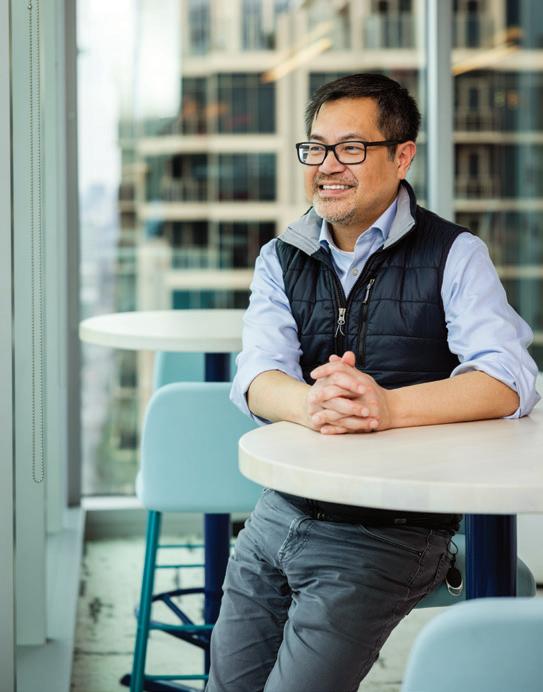
Tell us about the work you’re doing to build algorithms that can interpret mammograms that are used to screen for breast cancer.
Depending on where you are, it may take a radiologist a week to get around to reading your mammogram. We basically trained a machine-learning algorithm to read a mammogram. When you compare the algorithm to a radiologist, it does pretty well.
We are not trying to replace doctors, but if a radiologist has a hundred mammograms to read, we could tell them that these are the two you need to pay attention to today. That accelerates the time to care, and that is incredibly helpful in terms of
treatment. It also reduces anxiety for the women who are at risk.
So AI really can save the world — or at least improve health in parts of it?
You have to deal with the right safeguards to make sure that you’re maximizing equal outcomes and to make sure that you’re not actually doing harm, because there’s always the possibility of great harm with these tools if you’re not doing it right. One of the challenges of AI, for example, is that if you train the model using a biased dataset, it will be a biased model; it will pick up the unconscious bias that the data captures.
But there is also an opportunity to advance knowledge and improve the care that people deliver.
I remember traveling in the South Pacific in the 1990s. I had to go to the post office to make a phone call; that was the only place there was a phone.
Then I remember traveling in Africa in the 2010s, and everybody had cellphones. They skipped having landlines in people’s homes; it wasn’t necessary because of the advancement of technology. The Global South just leapfrogged that whole phase of development in tech.
I think we have the same opportunity with artificial intelligence to support decision-making and drive better outcomes. If we play our cards right, there’s an opportunity for the Global South to catch up to, if not surpass, what we’re doing here in the West. ◆
MAGAZINE.RICE.EDU 37
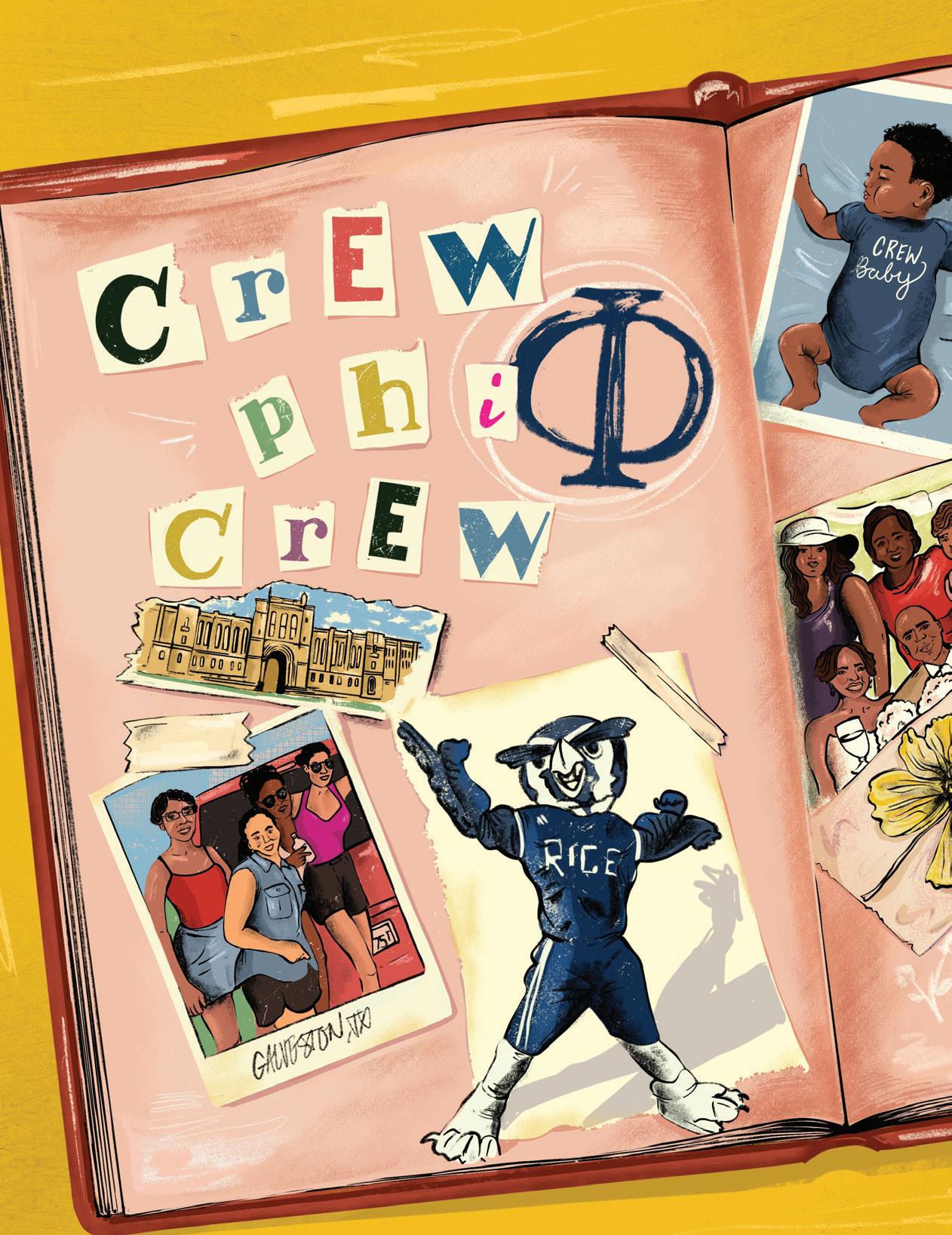
In the mid-1990s, a group of talented young students arrived on campus determined to succeed while enjoying university life to the fullest. As Black women attending a majority white college, opportunities to build close friendships were fewer, but these 10 women formed a lasting bond and became a crew for life.
 Illustration by Chloe Zola
Illustration by Chloe Zola
39
By Jenny West Rozelle ’00
Most of Crew Phi Crew’s 10 members — five from Will Rice College, four from Wiess College and one from Jones College — met during O-Week or while spending time in the John and Anne Grove between Will Rice and Hanszen. “We would hang out when we saw each other outside,” said Chaundra Frank ’00. “We met when we were 17 or 18 years old, and when we got together, we didn’t have any idea that here we would be, over 20 years later, still friends, still able to pick up anytime we meet.”
Many of the Crew are originally from Houston. While they were familiar with Rice, “We had no idea what we were getting ourselves into,” said Frank. “Rice was a little difficult for some of us. Our group was what kept a lot of us sane and gave us the courage and the confidence to keep going when we could have easily fallen to the wayside.” When they got together, they could forget about papers, exams and problem sets and simply enjoy the relationships they were building.
CREATING A CREW
Eventually, these undergraduate women commented that their group needed a name. Rice may not have a Greek system, but the idea of sororities served as inspiration to come up with their own goodhumored play on words: Crew Phi Crew. Although it was said in passing, the name stuck and the sentiment around it grew.
“The reason we chose this name specifically is because we have a sisterly bond, much like sorority sisters,” said Neema Jones Stephens ’99. “Several of us now have families of our own, and we refer to the children as ‘Crew babies’ and ‘Future Owls.’”
The group was, and is, more than just a name — it was a source of strength for some of these young women at a time in their lives that was full of changes and challenges. One challenge was something that the majority of Rice students in the 1990s didn’t face or fully understand. “A lot of African Americans I knew wanted to graduate and get out of there and never come back,” said Frank. “We had a different experience back then. There were very few African Americans on campus, and I think that was the connection [for our group], just to look up and see someone who looks like you and has something similar in their background.”
For a while after graduation, although Frank maintained her bond with Crew Phi Crew, she didn’t return to Rice at all, despite living in Houston. “I didn’t go back for years. Then Brandy [Hays Morrison ’98] came to us as a group and said, ‘Let’s go back to school,’” Frank recalled. Morrison received her MBA from Rice’s Jesse H. Jones Graduate School of Business in 2005 and encouraged her friends to do the same. “Several people in our close network of friends decided to go back. She really is the person in our group who is going to make everybody elevate.”
Frank graduated in fall 2022 with an MBA from Jones School and served as the inaugural president of the Rice Business Student Association for MBA@ Rice and president of Rice Business Board Fellows. In a full-circle way, she was also part of the Black Business Student Association — Morrison was one of the founders. “It’s that kind of thing that I love about our group,” said Frank, who is executive vice president of finance at the Houston Botanic Garden in addition to founder and CEO of nonprofit Lake Houston Youth
From left: Eleisha NelsonReed, Kadian McIntosh, Neema Stephens, AJ Beard, Jamila Nelson Mensah ’00, Shanita Woodard, Brandy Morrison, Kimberly Smith and Angelique Woods, ARUBA Gala, 2016

W
When you ask the women of Crew Phi Crew what has held them together for over 25 years, the answer is sisterhood — the kind that comes through friendship, dedication, shared experiences and lots of love.
40
Sports Association. “They’re a powerful group.”
Crew members have held many other leadership positions at Rice as well. AJ Moore Beard ’01 and Morrison have served on the Association of Rice Alumni Board. Morrison is a current member of the Rice Board of Trustees, and Kimberly Manney Smith ’00 is on the Friends of Fondren Library Board of Directors. Shaquandra Monette Roberson Porter ’00 is in the Rice Athletics Hall of Fame. While undergraduates, many of them were active in the Rice chapter of the National Society of Black Engineers — Morrison served as president and Smith as vice president — as well as the Black Student Association and ADVANCE (Advocating Diversity and Career Exploration).
SERIOUS FUN
Still, Crew Phi Crew hasn’t forgotten the lighthearted fun they had in their Rice days, and that remains part of the joy. Stephens, the national medical director for health equity at Cigna, remembers their first — and last — NOD. “After a trip to Target (pronounced ‘Tar-Jay’) for cute new pajamas, we were dolled up and ready to party. When we arrived, we quickly realized we were overdressed! We stayed for a brief while and laughed the entire time.”
Many other happy memories come to mind for the Crew, including spring break in Galveston, where they spent the whole time on The Strand and never saw the beach; Friday night dance parties in their rooms as they listened to the music blaring from the Sid Richardson College speakers and made up dance moves they still remember to this day; moving off campus and beginning a game night tradition of playing Spades or Taboo; and going to parties at the University of Houston or Texas Southern University. They even learned to belly dance together at Porter’s bachelorette party.
Angelique Woods ’99, director of shared services for capital assets and accounts payable at Enbridge, cherishes the memory of the 2016 Association of Rice University Black Alumni Blueprint for Excellence Gala: Celebrating 50 Years of Black Undergraduate Life at Rice. “Even though we are all professional women now, that night, we quickly slipped back into our old crazy antics, teasing and joking with each other as if no time had passed since we were in college.”
CONSTANT SUPPORT SYSTEM
Thanks to technology and group chats, Crew Phi Crew continues to communicate nearly every day, and their friendship has helped them navigate many life experiences. They have been there
for each other during some of the most difficult points in their lives, including the deaths of family members and the cancer diagnoses of a couple of group members. Without even having to call, they show up for each other.
Smith, who is a consulting director at Athenian Group, a managing and consulting company, echoed this sentiment. “As friends, it is the moments that make us truly human that strengthen our bond, such as the many celebrations — weddings, babies, marathons, a good diagnosis and a successful surgery — and our troubled waters, to sum up as loss. We are
Clockwise from top left: Neema Stephens, Kimberly Smith, Brandy Morrison, Kadian McIntosh, AJ Beard, Shanita Woodard and Angelique Woods, ARUBA Gala, 2016
Top row, from left: Neema Stephens, Eleisha NelsonReed, AJ Beard, Brandy Morrison, Angelique Woods, Chaundra Frank, Kadian McIntosh, Shanita Woodard and Shaquandra Porter; bottom row, from left: Frances Ann Cevallos ’99, Kimberly Smith and husband Faheem Smith at Kim’s wedding, 2014
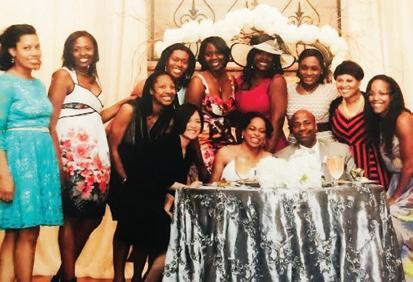
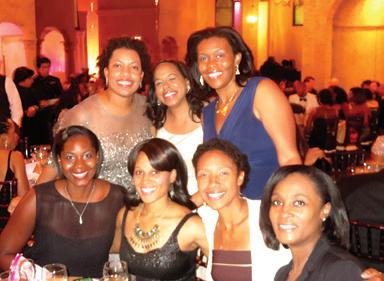
‹ From left: Tenisha Hall, AJ Beard, Chaundra Frank, Neema Stephens and Shanita Woodard, Friendsgiving, 2002

41
friends through thick and thin, victory and obstacle.”
Morrison added, “No matter what happens in life, they are my constant support system.”
Crew members, all of whom have earned graduate degrees in their respective fields, also support each other through job transitions, discuss how to facilitate career moves and frequently act as sounding boards for each other. Many of the women are leaders in their companies in occupations spanning consulting, entrepreneurship, medicine, law and accounting — and some of them hold positions at multiple companies.
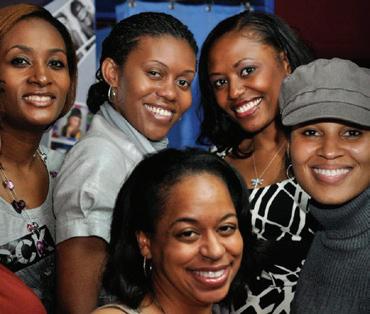

“The Crew connects with me on every level: as a Black woman, a mother, an athlete, a daughter, a wife, an engineer, a leader and a friend,” said Beard, the chief operating officer of Lone Oak Farm and Technology. “I have been able to connect with someone in the Crew to help me through professional hurdles, relationship advice, staying active and healthy, celebrating triumph and failure because they reflect me in all the ways that I am unique.”
IRON SHARPENING IRON
Morrison lives near Washington, D.C., where she is the vice president of strategic growth at Pluribus Digital, but she returns to Houston four times
every year for Rice Board of Trustees meetings. Since most of the Crew now live in the Houston area, they consider it mandatory to get together when she comes in. “We are a family, and when we come together, it is refreshing and empowering. Iron sharpening iron,” said Porter, who is an attorney in the office of Dick Dawson Attorney at Law as well as a youth pastor at Purfect Love Fellowship Church. “We can exhale from life’s demands and celebrate each other’s accomplishments and the positive impact we are making on those around us. We have the utmost respect, love and support for one another.”
The Crew has evolved over the years in how they spend their time together. They once took trips, had spa days and went to concerts, but now as much as ever, they appreciate the time spent together enjoying good food and good conversation. Shanita Woodard ’00, product marketing leader for Honeywell Connected Industrials and founder and owner of PICC Design, fondly remembers some of their meals as young alumni.
“Our potluck get-togethers were times to reconnect, to hug, share, dance, laugh and remember the experiences we’ve had together. Those were times when we could just unplug from the world around us and appreciate the joy and closeness of friendship.” Over the years, as friends moved away and back again, the potlucks changed to dinners out, but as Woodard said, “the warmth of fellowship with girlfriends remained the same.” At this point in their lives, the Crew will often reserve a whole room in a restaurant, where they stay for hours to catch up.
Eleisha Nelson-Reed ’99, the executive director of the Powell Foundation, a philanthropic organization, said, “What I appreciate most about this group is that there is still a down-to-earth quality where we can get together and have a tear-inducing laugh about random silliness as if we were still 19 years old and, in the next breath, have rich and nuanced conversations informed by our experiences and world views.” Eventually they may invite spouses and kids to their gatherings, but so far, they prefer to keep their get-togethers among the Crew.
“I cherish the sisterhood that this group of phenomenal women has represented as we continue our post-Rice lives,” said Kadian McIntosh ’00, a physician assistant at MD Anderson Cancer Center.
“We are Crew Phi Crew for life!” ◆
Do you have a story of an enduring Rice friendship through the ages? Tell us a little bit about your group and how it’s changed over the years by writing to ricemagazine@rice.edu .
42
From left: Eleisha Nelson-Reed, Angelique Woods, Brandy Morrison, Kimberly Smith, Neema Stephens and Shanita Woodard at Brandy’s bachelorette party, 2012
Clockwise from left: Kadian McIntosh, Brandy Morrison, Eleisha Nelson-Reed, Shanita Woodard and Kimberly Smith at a networking event, 2011
Come On Down!
A game show fanatic finds his voice in the crowd.
 BY LAURA FURR MERICAS
BY LAURA FURR MERICAS
MAGAZINE.RICE.EDU 43
PHOTO BY JEFF FITLOW
PROFILES, HISTORY AND CLASSNOTES
ALUMNI LIFE AF TER RICE
EUGENE BYON ’95 says game shows changed his life. The computer programmer has appeared six times on five TV game shows: once each on “Wheel of Fortune,” “The $100,000 Pyramid,” “Let’s Make a Deal” and “The Price Is Right” and twice on “Who Wants To Be a Millionaire?” He has brought home over $40,000 in cash and prizes and is aiming for more.
But what those appearances have helped to bring out in him is more meaningful than the money, Byon admits.
“I was very introverted growing up, and I think there was sort of this more enthusiastic personality that was wanting to come out,” Byon says. “Game shows were a way of making a connection with that part of myself.”
Byon was first introduced to game shows as a young child, watching them almost every day with his mother, who immigrated to the U.S. from Korea before Byon was born. While his mother
watched the shows to learn English, Byon recalls being drawn to the energy and the crowds’ fun-loving nature. By the time he was a toddler, he was playing along, encouraging contestants on the screen to “Come on down!”
At the age of 11, Byon moved back to Korea to attend boarding school, followed by studying computer science at Rice and earning a graduate degree from Indiana University Bloomington. During that time, game shows took a

back seat to his studies. But in 1998, while Byon was working as a software engineer for Exxon, the fascination was fueled again when “Wheel of Fortune” descended upon Houston for a week of filming. Byon, then 23, knew he had to give it a spin.
After waiting 15 hours in line and sleeping outside the studios, Byon caught the eyes of producers with his enthusiasm and larger-than-life gestures. His animated spirit carried over to the live taping — laughing madly as he spun the wheel and embracing host Pat Sajak in a giant hug when things didn’t turn out his way. But Byon says that excitement got the best of him that day. In an attempt to rack up more points before solving the puzzle, Byon eventually landed on the “Lose a Turn” space twice and left the show with nothing.
“I was just so enamored with the show that strategy went out the window,” he admits. But now, five game show appearances later, he says he’s found a way to balance his fandom with the facts, applying some of the statistical analysis he’s learned for and in his career.
For Byon, game shows opened up a whole new side of his career at Exxon, where today he’s working as an IT coach. There, he uses his “excessively loud and enthusiastic” personality to help technical teams improve their work practices in fun and productive ways. In one of his most popular presentations, “Big Money: IT Lessons Learned From TV Game Shows,” he likens delivering software to a client to his epic “Wheel of Fortune” loss. Lesson No. 1: “Don’t always go for the big win in one shot. Deliver value early and often instead,” he says.
He’s created games, based on classics like “Family Feud” or Pictionary, for teams too. He says he’s seen countless employees and managers become better teammates after playing a game together — and, perhaps more importantly, laughing together. “I advocate for the use of fun to be able to break down barriers,” he says. For Byon, game shows and business practices are part of the same deal.
ALUMNI 44 RICE MAGAZINE SPRING 2023
[Byon] has appeared six times on five TV game shows: once each on “Wheel of Fortune,” “The $100,000 Pyramid,” “Let’s Make a Deal” and “The Price Is Right” and twice on “Who Wants To Be a Millionaire?”
PHOTO COURTESY OF ABC/JACOB KEPLER
Byon with host Chris Harrison on the set of “Who Wants To Be a Millionaire?”
IN HIS PROFESSIONAL life, Rob LaVohn ’92 teaches high school English, striving to create a community of learners that is, by all accounts, positive, respectful and — according to one colleague — “seriously fun.” These are much the same qualities he brings to his role as founder and moderator of the officially unofficial Rice Facebook
group, “Let’s Be Honest: We Can’t Get a Million Fans for Rice University,” a social media experiment that started “as a lark” 13 years ago.

In 2010, LaVohn was feeling cut off from Rice, where he earned degrees in English and sociology, participated in the MOB for four years, and was a devoted Wiessman. Setting up the page “was a joke,” he recalls, one that echoed a popular Facebook meme called “A million fans for [insert name of college].”
LaVohn shared the page with a few Rice friends and then watched in astonishment as its followers grew every day.
To keep the group engaged, LaVohn started throwing out topical requests such as asking followers to share memories: their favorite dorm room “build-up,” a rule they broke or a haiku describing Beer Bike.
LaVohn not only reconnected with old friends and made new ones but also built a sounding board for a wide variety
of hot topics involving Rice policies, current events and administrative decisions. In summer 2010, Rice leaders announced plans to sell KTRU to the University of Houston — a sale that was finalized the following year. LaVohn summed up followers’ sentiments at the end of 2010: “Rice still does not have a million fans. It does, however, have about a million people ticked off about KTRU.”
More challenging discussions have ensued, including ongoing loops about Rice Athletics and the fate of the statue of founder William Marsh Rice. The latter debates became increasingly tense in 2020, as painful instances of racial injustice roiled the nation. Followers not only had opinions but also had opinions about other people’s opinions.
“Even Rice alums forget from time to time that they’re talking to real people online,” LaVohn observes. However, “most of the time, a gentle reminder is all it takes to restore positive discourse.” All the moderators — LaVohn, Anastasia Bolshakov ’15, PJ Abrams ’92 and friend Philip Owens — have worked hard to maintain a space that is respectful of free speech but does not descend into personal attacks.
On a more entertaining note, the page revels in owl photos — the feathered types far outnumber the human kind. “So many owl photos,” LaVohn sighs. Ever see a video of a snowy owl flying straight at a traffic cam? Yes? Well, here it is again. Then there’s the enduring “meta thread,” which LaVohn describes as a long-running reflection on social media and Rice. It started when he jokingly posted statements like “[ambiguous statement designed to cause a debate]” and “people immediately picked up on it,” he says.
Today, nearly 6,500 fans follow along, and no one is more surprised than LaVohn at the group’s longevity. “I mean, I made a joke and people laughed at it. And they’re still laughing.”
— LYNN GOSNELL
Read an extended version of this story at magazine.rice.edu.
ALUMNI ILLUSTRATION BY EVA BEE MAGAZINE.RICE.EDU 45
[Informative Yet Clever Headline]
COMMUNITY
A Facebook page founded by Rob LaVohn has become a popular outlet for alumni to share news and opinions — and a gazillion images of owls.
New Models for Detecting Skin Cancer
Roxana Daneshjou is working to make skin cancer screening more inclusive — and more accurate.
ACCORDING TO THE American Academy of Dermatology, 1 in 5 Americans will develop skin cancer during the course of their lifetime. If caught early, these cancers are highly treatable, with an impressive survival rate. However, when it comes to early detection and diagnosis, patients encounter major
barriers, including limited access to a dermatologist and physicians who are insufficiently trained about the signs of skin cancer in a diverse set of patients.
“Historically, there is a very large lack of representation,” said Roxana Daneshjou ’09, a clinical researcher in dermatology at Stanford University. “It goes back to the lack of representation in textbooks and educational materials.” Existing images and training are disproportionately focused on what
skin cancers look like in white patients, while the warning signs can look very different in non-white patients.
For example, a basal cell carcinoma is typically described as being pink and curly, which is what it looks like on white skin, but it is often pigmented on brown skin. Without proper training for physicians, these carcinomas can go undetected for a longer time. As a result, minority patients are often diagnosed with skin cancer later than their peers and consequently experience worse outcomes in terms of treatment and survival.
When it comes to helping patients access dermatological care, new AI programs can screen images of potentially problematic lesions and make predictions as to which ones need to be referred to a specialist. “These tools could help empower physicians who are not dermatology specialists to help make decisions,” Daneshjou said. Given that an estimated 3 billion people worldwide lack access to a local dermatologist, this type of tool can help patients receive critical referrals. However, as with the current training methods for detecting skin cancers, the images used for training these AI programs lack diversity. “The exclusion of images of diverse patients from these models is a huge problem that is going to perpetuate existing disparities,” Daneshjou said.
Daneshjou and her collaborators recently published research showing that current AI models were less accurate at detecting cancerous lesions in images of minority patients. However, they also showed that accuracy could be improved by training the models on a more diverse data set — one that Daneshjou and her collaborators created — and by making some modifications to the program.

“When you give an AI program some additional examples of diverse data, and then you test this program on diverse data, it starts doing better,” Daneshjou said. “It’s probably not that different from humans. If you start to train humans properly to be able to recognize skin cancers across diverse skin tones, they would get better at doing so.” —
RACHEL FAIRBANK
46 RICE MAGAZINE SPRING 2023 PHOTO BY NICO OVED
HEALTH
PUBLIC
Existing images and training are disproportionately focused on what skin cancers look like in white patients when the warning signs can look very different in non-white patients.
True Love, Growing Oysters and Castro’s Daughter

Excerpts from Owlmanac

1980s
“It’s been a long time since my last confession. I married a perfect woman (smart and attractive, with questionable taste in men), Riki Rushing. Riki and I have been producing and executive producing films for the past four years, including the upcoming film about Fidel Castro’s daughter, Alina — where our partners were fellow Ricecateers Joe Lamy ’98 (Sid Rich: BA) and his sister, Marielle Lamy Quaid ’07 (Hanszen: BA, 2008) — a movie that gained global notoriety after we cast James Franco as Fidel Castro.” — Contributed by Allen Gilmer ’83 (Will Rice: BA, 1984)
1950s
“Cody Caldwell Greenwood ’58 (BA) lives in Houston, retired after a stellar career as one of the founding owners of the Greenwood King real estate firm. She is a busy bee, participating in Bible study at St. John the Divine Episcopal Church, regularly attending meetings of the 100-year-old charitable Blue Bird Circle of Houston organization, and brightening this writer’s every day with her beauty, warm presence, engaging conversations and smile.”
— Contributed by class recorder Jim Greenwood ’58 (BA)
1980s
“I’ve made a big career shift and couldn’t be happier or more fulfilled. Now I’m serving as the chaplain at Dallas Life Homeless Recovery Center. Our claim to fame is a 10-month ‘homeless no more’ program; we have a 90% success rate for clients who graduate. Every day is packed with ministry. Bliss!”
1960s
“We are master naturalists and spend many hours trying to restore the prairie at Galveston Island State Park, pick up trash and monofilament line from the beaches, grow oysters in our ‘backyard’ and rescue stranded turtles.” — Contributed by Olivia Thomas Meyer ’65 (Jones: BA)
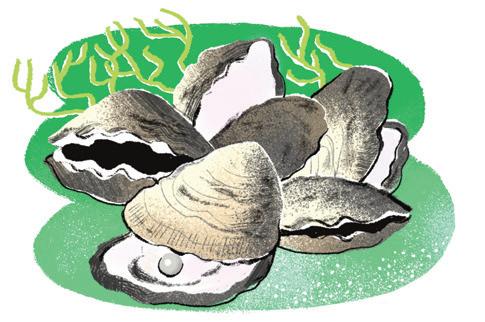
— Contributed by Scott Daniel
“Dan” Sullivan ’87 (Wiess: BA)
2000s
“It was a banner year for moi, considering the publication of my book, which earned me tenure at the University of Illinois UrbanaChampaign; I joined the ~7% Latinx faculty that comprise all tenured professors in academia. P.S. Someone let my old adviser in political science know that my double major in French turned out not to be pointless, and that my research ended up combining both fields.”
— Contributed by class recorder Felisa Vergara Reynolds ’00 (Will Rice: BA; MA, 2002)
To submit a Classnote to Owlmanac, contact your class recorder or log on to the Rice Portal at riceconnect.rice.edu and click “Submit a Classnote.” Excerpts from Owlmanac may be edited for length.

ALUMNI ILLUSTRATIONS BY DELPHINE LEE MAGAZINE.RICE.EDU 47
CLASSNOTES
Now Reading
ground coconut butter, and I was like, this is just a totally different world from anything I had ever been doing.
Some readers have described the book as surreal or dreamlike. Did you set out to write it that way?
What is the relationship between music and writing for you?
I don’t think I could do one without the other. I started writing short stories and poems to go with music for program notes. I found that came really easily because I always am visualizing things and seeing things in my mind when I’m playing. And then, when I’m writing, similarly, I love listening to classical music. So I do them in tandem, and I think they enrich each other. It’s an act of, almost, translation between the two.
I didn’t have a set kind of tone or idea, but I think it represents a lot of the natural beauty industry itself, where they’re using the most cutting-edge biotechnology and they’re putting all of this NASA-backed research into changing on a cellular level — but for the most “natural” look, or for you to “be yourself.” It’s a really strange and surreal industry, and I think it’s natural to write a book that ended up reflecting those qualities.
If people could take away one message or one idea from the book, what would you want it to be?
Natural Beauty
Ling Ling Huang ’14
Penguin Random House, 2023
IN LING LING HUANG’S surreal and darkly humorous debut novel, “Natural Beauty,” the unnamed narrator abandons her budding career as a virtuoso pianist when her beloved immigrant parents are badly injured in an accident. To pay for their care, she takes a job at a high-end natural beauty and wellness store and there finds herself pulled into an increasingly horrific world that challenges her sense of agency and identity and gradually decays the well-being of herself and everyone around her.
Huang is also a real-life virtuoso musician — although with the violin — whose parents immigrated to escape the Cultural Revolution in China. We spoke to Huang about the relationships between music and writing, writer and narrator, and beauty and authenticity.

What made you decide to satirize beauty and wellness?

After my time at Rice, I moved to New York, and before I could plug into the freelancing scene for music to make ends meet, I was working at a natural beauty and wellness store. I was selling $400 water filters to board members of the Whitney Museum of American Art and actresses and politicians. My first day, they gave me a gigantic golden spoon to dig out organic stone-
Treasure yourself and understand that every part of you comes from somewhere. There’s ancestry, lineage, heritage, and all of that is more beautiful than any trend or any new TikTok beauty method. Don’t betray yourself. And don’t think that you don’t have anything to lose when you’re trying to become someone else or become your “best self.”
— INTERVIEW BY HILARY C. RITZ
Read an expanded version of this interview at magazine.rice.edu.
ALUMNI 48 RICE MAGAZINE SPRING 2023 BOOKS
BOTH SUPPORTERS
and detractors of Barack Obama expected radical reform from his presidency. But even Obama’s most groundbreaking policy achievement, the Affordable Care Act, was more conservative than radical, argues Burton I. Kaufman.

In “Barack Obama: Conservative, Pragmatist, Progressive,” Kaufman, professor emeritus of history and dean emeritus of the School of Interdisciplinary Studies at Miami University of Ohio, examines the differences between perceptions and the reality of Obama’s presidency, concluding that ultimately, Obama was an economic conservative and a political pragmatist. “His conservativism explains why he became so criticized both by Democrats on his political left and Republicans on his political right and accounts in part for the congressional deadlock that he encountered throughout much of his administration,” Kaufman writes. Even as the Obama administration maintained the nation’s existing free enterprise system, however, Obama’s efforts to expand opportunities for marginalized groups set him apart from past presidents. Kaufman concludes that future historians will consider him one of America’s best post-World War II presidents, along with Harry S. Truman and Dwight D. Eisenhower.
— JENNIFER LATSON
The Myth of American Inequality

How Government Biases Policy Debate
IN A 2020 article, The Economist asserted, “It is a truth universally acknowledged that inequality in the rich world is high and rising.” That assertion was grounded in worrying statistics from the U.S. Census Bureau and the Bureau of Labor Statistics, which indicate that income inequality has grown steadily since World War II. But those statistics are wrong, say the authors of “The Myth of American Inequality.”
The book’s authors — former Texas Senator Phil Gramm, economist Robert Ekelund and John Early, a former assistant commissioner at the Bureau of Labor Statistics — paint a much rosier picture of American economic wellbeing, arguing that income inequality is, in fact, lower now than at any point in the past 75 years. They posit that the Census Bureau has substantially understated the income of low-income Americans; using their own analysis of the data, they conclude that income inequality is only a quarter of the official census measure. “The resulting picture shows a very different and better America than the one that is currently portrayed in the official statistics of the nation and described by advocates across much of the political spectrum,” they write. “In postwar America, we have experienced strong and widely shared prosperity.”
— J.L.
The Lawless Land
Beth Morrison and Boyd Morrison ’89
Head of Zeus, 2022
A FEW YEARS back, Boyd Morrison was already the bestselling author of a dozen thrillers, six written in collaboration with the late Clive Cussler, underwater explorer and adventure writer extraordinaire. Boyd’s sister, Beth Morrison, an expert medievalist with a Ph.D. from Cornell and the senior curator of manuscripts at the J. Paul Getty Museum, was an avid reader of her brother’s books. So when Boyd asked Beth if she would be his next collaborator, setting a series in the Middle Ages she’d spent decades mastering, she called it “a dream come true.”
Their new novel, “The Lawless Land,” is an action-adventure romp that effectively meshes Boyd’s narrative skills with Beth’s attention to historical detail. Protagonist Gerard Fox is an English knight errant determined to clear his family’s name after a corrupt cardinal destroyed it to cheat them of their land. But Fox is swept off track by a beautiful lady fleeing with a secret she’s protecting with her life and which the very same cardinal would do anything to discover. The twistsand-turns chase covers plenty of (literal and figurative) territory, from tavern brawls and passages by ship to skirmishes at convents and castle tournaments, and it is pleasingly fast paced for a doorstop tome. — H.R.

MAGAZINE.RICE.EDU 49
Barack Obama Conservative, Pragmatist, Progressive
By Burton I. Kaufman ’64, ’66 Cornell University Press, 2022
Phil Gramm, Robert Ekelund and John Early ’66 Rowman and Littlefield, 2022
LAST LOOK


50 RICE MAGAZINE SPRING 2023
Feb.
PHOTO BY GUSTAVO RASKOSKY
4, 2023
// Moody Center for the Arts // Artist Bennie Flores Ansell installs “Swarm Migration.”
“These charitable gift annuities allowed me to give toward a cause I feel passionate about while keeping my own finances stable,” Katherine said. “I am thrilled that this money will eventually become a part of the endowment and continue to help students for generations.”
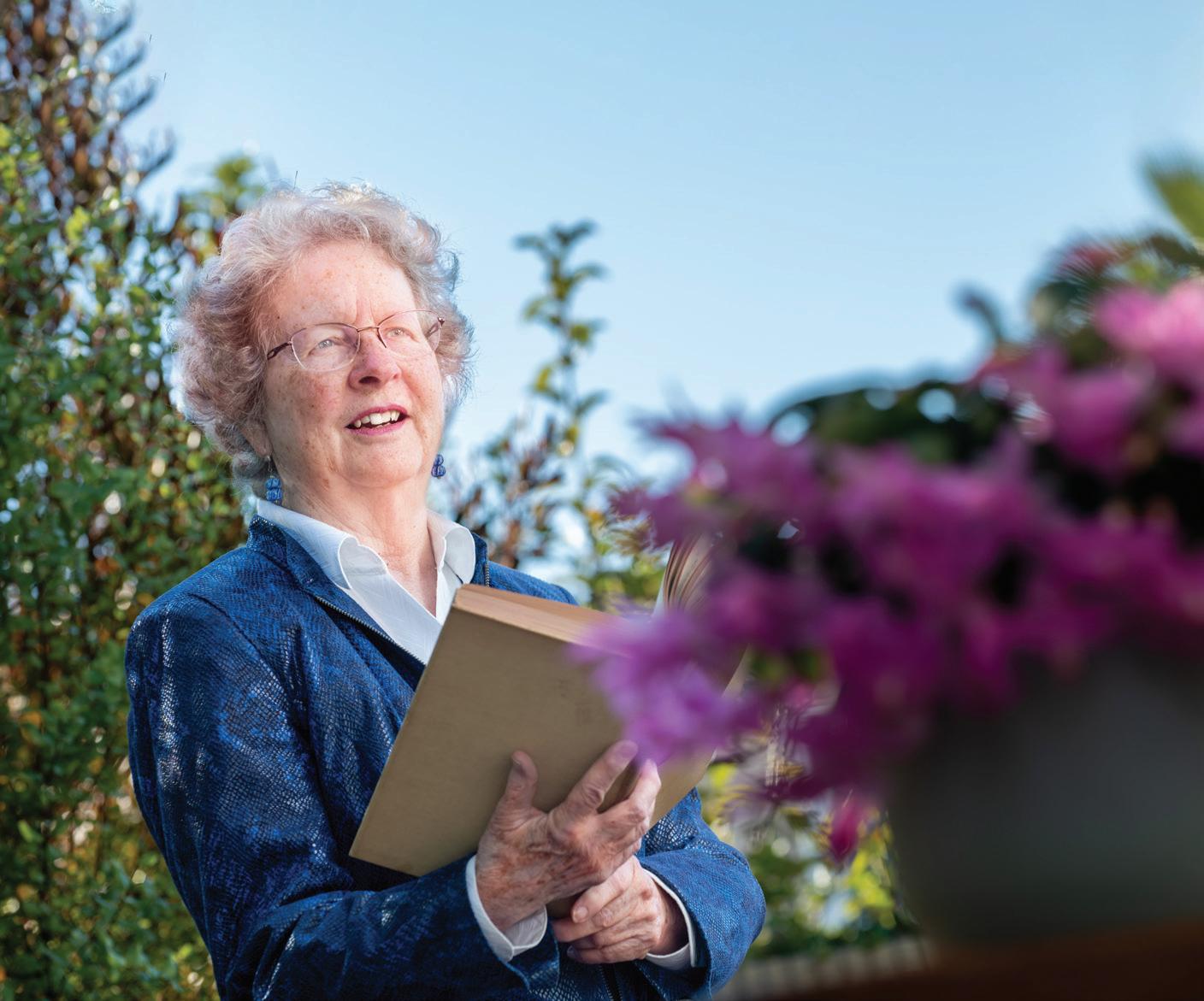

To learn more about Katherine’s story, visit giving.rice.edu/crockett
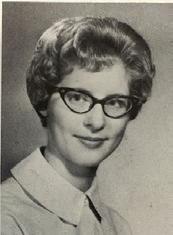

learn how you can make a difference at Rice through charitable gift annuities, contact the Office of Gift Planning at giftplan@rice.edu or 713-348-4624.
Masoner Crockett ’64, who
to Rice to study mathematics,
charitable
To
Katherine
came
has long wanted to pay forward the tuition-free education she received from Rice. To do this, Katherine has established two
gift annuities. These annuities provide quarterly payments to Katherine for life, and later, the remainder of the gift will go toward a need-based scholarship to support female undergraduate STEM students.
Create Opportunity Through Wise Gift Planning To Rice Be True
.
Katherine as a student at Rice in 1964
Katherine Masoner Crockett ’64 in 2022
Rice University, Creative Services–MS 95

P.O. Box 1892 , Houston, TX 77251-1892
With
a Flourish
SOME OF THE MOST RECOGNIZABLE CONDUCTORS in the classical music world, including Patrick Summers, Andrew Grams and Hans Graf, have been taking the stage at Rice University’s Shepherd School of Music, marking the first time in the school’s history that such a variety of internationally renowned conductors have worked with its orchestras.

Following the death of longtime Shepherd School conductor Larry Rachleff last fall, Shepherd School Dean Matthew Loden said the search for a new orchestra director presents a unique opportunity for the school and its students to experiment with finding new voices. All told, nine noteworthy conductors will have led performances by the end of the 2023–2024 season.
“Being able to capture such conducting talent is a real coup for our music school and is a true testament to [its] reputation,” Loden said.
Patrick Summers, artistic and music director of the Houston Grand Opera, is slated to conduct Strauss’ “Salome’s Dance” and “Ein Heldenleben” and Brahms’ “Variations on a Theme of Joseph Haydn” April 21, closing out the current season. “To help unlock this summit of orchestral storytelling for a new generation is incredibly exciting and inspiring,” Summers said. Tickets for the 2023–2024 season will be available in August.
— AMY MCCAIG
WEB EXCLUSIVE
On Target
Archer, musician, artist, dancer and pre-med student — senior Katherine Wu’s many pursuits as a student provide balance, connection and joy to her life. Videographer Brandon Martin caught up with Wu as she trains to compete in the 2024 Paris Olympics and took time to give President DesRoches some pointers.

VIDEO A Grand Grad
Our “Spaces” department features Joseph Asfouri ’23 at the wellplayed Baldwin grand piano that’s graced the Rice Memorial Center since it was gifted to Rice in 1958. He also co-leads the club crew team and, most impressively, was recently named one of 18 U.S. college students awarded the Churchill Scholarship for study at Cambridge University. Videographer Brandon Martin captured Asfouri’s multiple talents in one joyful video.
VIDEO Study In Yellow and Black
“KTRU is a small place with a big personality,” says Rice photographer Gustavo Raskosky. His images and videos capture the station’s unique spirit for Joe Nick Patoski’s feature about KTRU and its archive of music reviews — a trove that links DJs past and present to this beloved institution.

Nonprofit Organization U.S. Postage PAID Permit #7549 Houston, Texas
ON THE WEB magazine.rice.edu

 Lovett Hall mirrored in puddles of rain on the morning of Feb. 1, 2023
PHOTO BY BRANDON MARTIN
Lovett Hall mirrored in puddles of rain on the morning of Feb. 1, 2023
PHOTO BY BRANDON MARTIN






















 LYNN GOSNELL
LYNN GOSNELL



 — MABEL TANG ’23
— MABEL TANG ’23
 — TRACEY RHOADES
— TRACEY RHOADES


 BY AMY MCCAIG
BY AMY MCCAIG







 Anna Rhodes and Max Besbris
Anna Rhodes and Max Besbris

 Edited by Jesús
Vassallo and Sebastián
Edited by Jesús
Vassallo and Sebastián

 Community DJ Ashley Turner hosts the show “Afternoon Delight” with longtime friend Nicole Buergers.
Community DJ Ashley Turner hosts the show “Afternoon Delight” with longtime friend Nicole Buergers.






















 Photos by Audra Melton
Physician Von Nguyen at Google headquarters in Atlanta
Photos by Audra Melton
Physician Von Nguyen at Google headquarters in Atlanta


 Illustration by Chloe Zola
Illustration by Chloe Zola






 BY LAURA FURR MERICAS
BY LAURA FURR MERICAS





















